



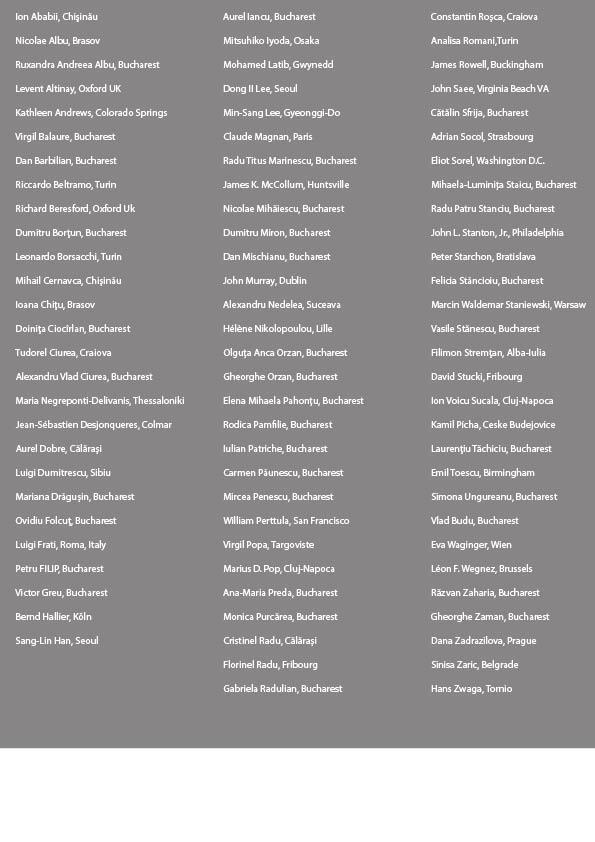

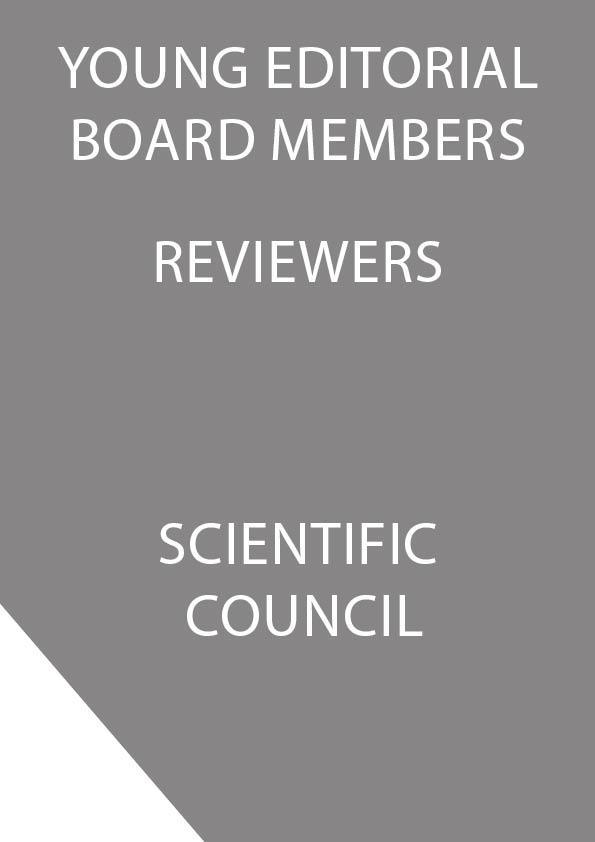





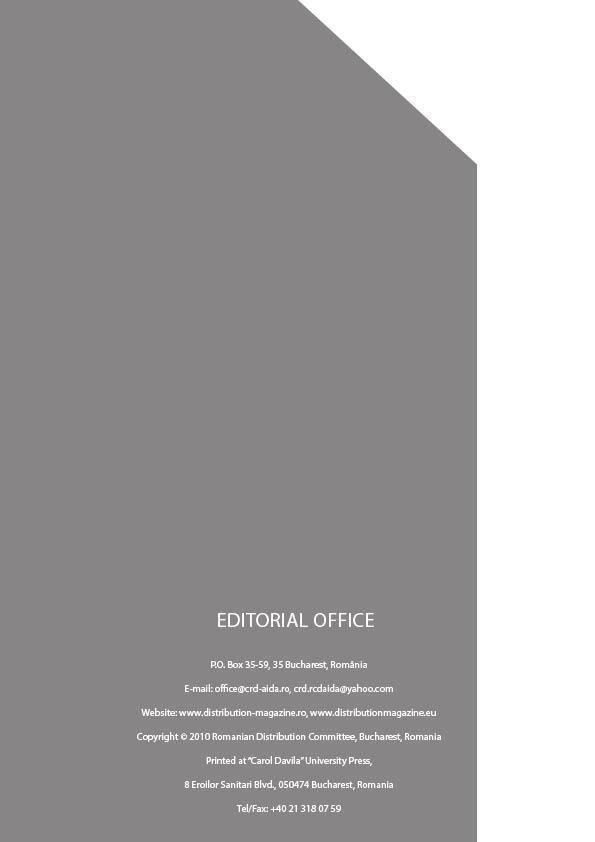



Always being open to learn, always on the path of wide spreading challenging opinions to maximize knowledge, we launched some practices within the context of the evolving Retail Reinvention (https://www.crd aida.ro/2022/09/widening-perspective-by reinvention/). Always working collaboratively, and sharing ideas and responsibilities, we pursued emerging opportunities, confirming, among other aspects, that the demand perspective can really lead to some novel descriptions of the retail market. We sought to go beyond explanations for the usual intuitive understandings and to study some key dimensions of the life of the strategic retailer-consumer partnership in the new normal that is being redefined every day. Our interpretations and developments have resulted in drawing a logical thread (resulting from interdisciplinarity, for instance) that sometimes, unfortunately, has not been noticed or that perhaps did not want to be noticed. We were surprised, for example, by the specific ways some persons can approach the exploratory, transformational, and combinational creativity. We even found, unfortunately, how the reality of a repeatedly clearly described situation can be completely ignored, despite the fact that as we all know: the logic and empirical evidence govern the real world; a complex approach cannot be something formal, complexity science being characterized by nonlinearity, unlike linear (traditional) thinking. This made us think of what the reputed social scientists Daniel Kahneman and Amos Tversky highlighted with regard to the interference between the way of perceiving reality and the various cognitive biases (such as the so-called “Reactance”, “Framing Effect” or “Belief Bias”).
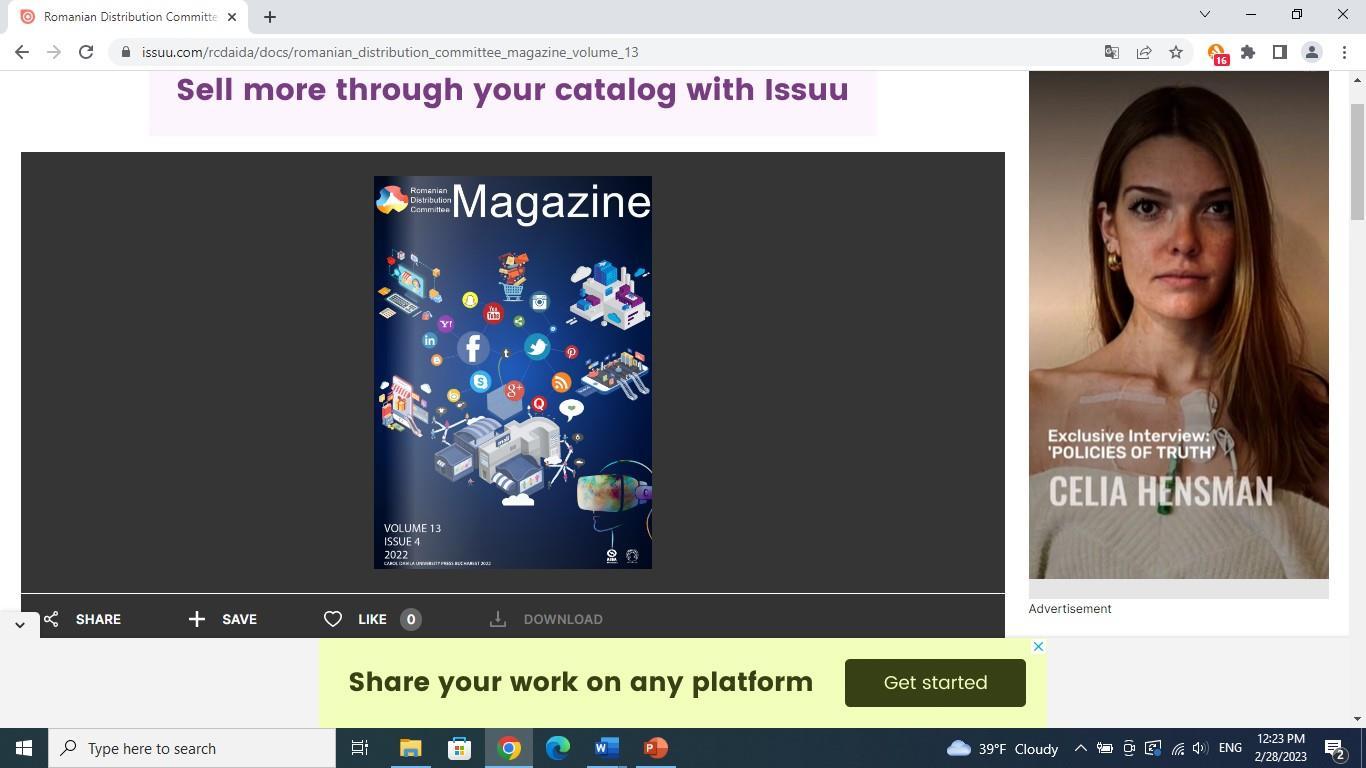
And while exchanging ideas on the phygital retail future, we also remembered some wise words: “You can’t just keep doing what works one time, everything around you is changing. To succeed, stay out in front of change” (Sam Walton); “Change is the law of life. And those who look only to the past or present are certain to miss the future” (John F. Kennedy); “The measure of intelligence is the ability to change” (Albert Einstein). Allow us to also remember that in the last RDC Magazine issue (Purcarea, 2022) we made reference to the fact that beyond the difficulty to build a better world within the described current very complicated challenges it is necessary to try to keep it simple along the right way, keeping in mind the wise words spoken by the famous Romanian sculptor Constantin Brancusi: “What is real is not the external form, but the essence of things” . On the other hand, as an interesting coincidence, we very recently found out from McKinsey & Company:
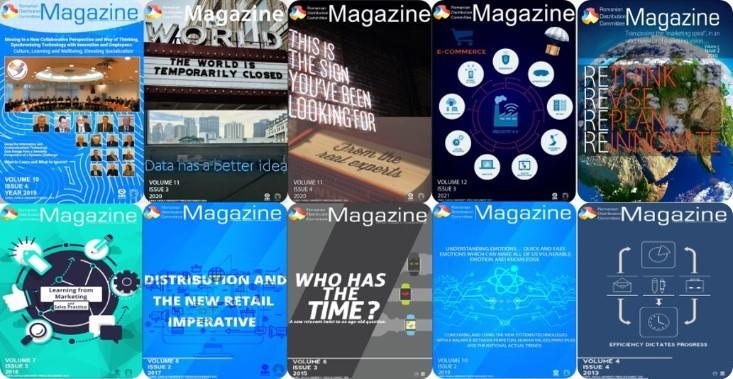
Editorial: Retail Ongoing Reinvention
Machine Knowledge Capital
5
- How “the best ideas can emerge at the intersection of cultures and opinions”, and leaders’ need “to be aware of cultural differences that may crop up during debate”, as well as how important is to “offer another take… and then allow the momentum of the conversation to take over” (Fletcher et al., 2023);
- That (according to the former executive Chairman and CEO of Cisco Systems and Founder and CEO of JC2 Ventures, John Chambers) “The speed of change is the new norm, and the speed of change with agility is very important” (McKinsey Digital, 2023);
- Companies need to make the investment in human and organizational capital as productive as possible (Madgavkar et al., 2023);

Source: Madgavkar, A., Schaninger, B., Maor, D., White, O., Smit, S., Samandari, H., Woetzel, J., Carlin, D. and Chockalingam, K., 2023. Performance through people: Transforming human capital into competitive advantage. [pdf] McKinsey Global Institute, February 2, 2023, p. 7 (work cited)
And as shown by Portell (2023), in any economic climate, businesses are challenged to invariably ensure improved experiences to their customers, based on the right collection and democratization of insights, and apply them on the necessary ongoing basis, confirming the understanding of their customers’ needs and pain points. What made us also think, among other aspects, to:
• What is known at Amazon as “Day 1” (culture), putting customer at the center of Amazon’s culture and operating mode, persisting with this task at hand, and keeping away the practices impeding company’s progress, avoiding this way the “Day 2” (culture), constantly assessing potential threats; in his wellknown 2016 Shareholder Letter the reputed Jeff Bezos described Day 2 as: “stasis. Followed by irrelevance. Followed by excruciating, painful decline. Followed by death. And that is why it is always Day 1” (Slater, n.d.);
Figure no. 1: Organizational elements prioritized by each category of company, based on Organizational Health Index surveys and other metrics
6
What Dr. Werner Vogels, Chief Technology Officer at Amazon.com, predicted (within the context of the above-mentioned Amazon’s struggling to ensure that at Amazon it is always Day 1) for 2023 and beyond with regard the advanced innovative technologies proliferating this year, and allowing including to “re-imagine the supply chain from the warehouse to delivery” (AWS Executive Insights, 2022);
• What The Brookings Institution, Washington, DC, let us know with regard to a recent Report
“USMCA (The United States-Mexico-Canada Agreement) Forward 2023: Building more integrated, resilient, and secure supply chains in North America” – from the point of view of the current era, “Machine knowledge capital (the present and forward)”, including by making reference, for instance, to: “the myriad yet-unknown applications that are now being developed are deployed in the production of goods and services, they will form a growing stock of capital assets”; “OpenAI’s recently released ChatGPT (OpenAI, 2022) is turning heads with its ability to respond with plausible intelligence to questions in conversational mode” (Ciuriak, 2023);
• What the AI “poet” ChatGPT generated when asked to write about the death of selling by the inspired and inspiring Founder and CEO of Objective Management Group, Inc.: “Selling, oh selling, how you’ ve changed, /… Customers now are more aware, / They’re educated and they’re prepared, /… It's not about what we can sell, / But how we can help them excel, / Our job is now to listen and learn, / To provide insights that make them yearn. /… To serve our customers with all our might, / And make our business soar to new heights” (Kurlan, 2023);
• What Walmart Global Tech (Walmart’s technology and software engineering arm) said in a set of generative AI tools’ usage guidelines for their employees about entering confidential information into ChatGPT and other generative AI tools – all these new tools must be used “appropriately” (Business Insider, 2023);
• What OpenAI (Chen, 2023) very recently showed on its blog regarding ChatGPT upgrades, dedicated instances, ChatGPT API, early users of ChatGPT (introduction of Q-Chat, launch of My AI for Snapchat+, augmenting of the Instacart’s Ask Instacart, powering of Shopify’s Shop app) and Whisper APIs.
Four years ago, we wrote in our RDC Magazine about retailers’ reinvention in harmony with the shopping tendencies (Purcarea, 2019), making reference to retailers’ struggling to become more technology-enabled so as to better understand customers’ context and offer them a true Omni channel experience, noting within that framework significant aspects, such as: how Amazon’s involvement in U.S. grocery ecommerce’s fierce competition with Walmart, Kroger etc. stimulated the innovation on the path to build high value retail experiences; how an adequate AI-powered personalization engine integrated with the in-store customer engagement analytics can enable BOPIS to ensure clear benefits for both customers, and retailers; how retailers are challenged to consider the impact of automation and AI technologies across all core functions, taking into account not only the workforce implications, but also the shopping tendencies (shopper behavior being reinvented by the digital revolution); how this developmental steps also reflect the importance for the next-generation retail merchandising of analytics and digital. Two years ago (Purcarea et al., 2021), we showed how the reinvention of the retail organizations, and retailers’ advancement on the path to the Next Normal is involving retailers’ acting on the new patterns and behaviors, considering: the new technology adoption within the pandemic context; consumers’ perceptions (within the context of the offline-online convergence, and consumers’ use of mobile phones in their Omni channel shopping journey) of AI as a central metric for assessing the successful use of AI-enabled interactions.
•
–
7
Last year (Purcarea et al., 2022), we highlighted how digitalization is impacting the retail industry, considering consumers’ relationship and engagement within digital transformation, retailers’ phygital strategies and the sustainable smart store of the future, and purposeful retail and shopping. While very recently (Purcarea, 2023), we made reference to ChatGPT’s possibilities for revolutionizing both marketing strategies (enhancing marketing processes and effectiveness), and CX, as well as to the competition between ChatGPT, Bing’s new chatbot and Bard chatbot, despite the decline in investment in marketing technology industry.
If a year ago, as shown by Eliyahu (2022) in Forbes, in today’s digital world retailers are under pressure to reinvent themselves, recent research findings by Square and Wakefield Research (Deutch and Rollings, 2023) revealed how the shopping experience this year will be continuously reshaped by retailers digitizing their operations and implementing new ways of selling, while carefully looking at the impact of inflation on goods’ cost, at the economic recession, as well as the supply chain disruptions. And speaking about inflation, it is worth mentioning that as highlighted from the very beginning of the year in World Financial Review (Bjerg, 2023): “Most experts believe that 2023 will bring some form of recession, but there’s disagreement regarding severity and timing… 2023 will most likely disclose whether a year of inflation will be out in recession, or whether the interest hikes from the European Central Bank and the Federal Reserve can break the inflation without creating a recession.”
Anyway, the important thing is not to forget… the essence of things.
Theodor Valentin Purcărea Editor-in-Chief
References
AWS Executive Insights, 2022. Werner Vogels’ Tech Predictions for 2023 and Beyond, Amazon, Innovation, December 2022. [online] Available at: <https://aws.amazon.com/executive-insights/content/werner-vogels-2023-tech-predictions-and-beyond/?> [Accessed 1 March 2023].
Bjerg, E., 2023. 2023 in a Global Perspective: What to Pay Attention to in the Year Ahead, World Financial Review, January 2, 2023. [online] Available at: <https://worldfinancialreview.com/2023-in-a-global-perspective-what-to-pay-attention-to-in-theyear-ahead/> [Accessed 13.01.2023].
Business Insider, 2023. Leaked Walmart memo warns employees not to share 'any information about Walmart's business' with ChatGPT or other AI bots, February 2023. [online] Available at: <https://www.businessinsider.com/walmart-warns-workersdont-share-sensitive-information-chatgpt-generative-ai-2023-2?> [Accessed 1 March 2023].
Chen, R., 2023. Introducing ChatGPT and Whisper APIs, OpenAI blog, March 1, 2023. [online] Available at: <https://openai.com/blog/introducing-chatgpt-and-whisper-apis?> [Accessed 2 March 2023].
Ciuriak, D., 2023. Data flows and critical technologies, Chapter 6, in “USMCA FORWARD: Building more integrated, resilient, and secure supply chains in North America”, Research, February 2023. [online] Available at: <https://www.brookings.edu/essay/usmca-forward-2023-chapter-6-data-flows-and-critical-technologies/> [Accessed 1 March 2023].
Deutch, K. and Rollings, M., 2023. The Top Retail Trends in 2023, Square, 02.02.2023. [online] Available at: <https://squareup.com/us/en/townsquare/retail-trends> [Accessed 2 March 2023].
Eliyahu, S., 2022. Why The Retail Industry Needs To Reinvent Itself In A Digital World, Forbes, Feb 4, 2022. [online] Available at: <https://www.forbes.com/sites/forbestechcouncil/2022/02/04/why-the-retail-industry-needs-to-reinvent-itself-in-a-digitalworld/?sh=27c30fa7192f> [Accessed 2 March 2023].
Fletcher, B., Hartley, C., Hoskin, R. and Maor, D., 2023. Into all problem-solving, a little dissent must fall. [pdf] McKinsey & Company, People & Organizational Performance Practice, February 2023, pp. 1-8. Available at: <into-all-problem-solving-alittle-dissent-must-fall-vf> [Accessed 27 February 2023].
Kurlan, D., 2023. 4 Types of Sales Positions That Can Never Be Replaced by AI, CustomerThink, February 25, 2023. [online] Available at: <https://customerthink.com/4-types-of-sales-positions-that-can-never-be-replaced-by-ai/?> [Accessed 28 February 2023].
Madgavkar, A., Schaninger, B., Maor, D., White, O., Smit, S., Samandari, H., Woetzel, J., Carlin, D. and Chockalingam, K., 2023. Performance through people: Transforming human capital into competitive advantage. [pdf] McKinsey Global Institute, February 2, 2023, p. 7. Available at: <Transforming human capital into a competitive edge _ McKinsey> [Accessed 13 February 2023].
8
McKinsey Digital, 2023. John Chambers: ‘Breaking away during the tough times is when the next generation of great companies gets formed’. [pdf] McKinsey & Company, February 2023, p. 2. Available at: <john-chambers-breaking-away-during-the-toughtimes_final > [Accessed 23 February 2023].
Portell, S., 2023. How a People-Centric CX Strategy Drives Customer Retention, CustomerThink, February 22, 2023. [online] Available at: <https://customerthink.com/how-a-people-centric-cx-strategy-drives-customer-retention/?> [Accessed 28 February 2023].


Purcarea, T., 2022. Lessons to Learn in Adapting to Market Uncertainty. Limitation of Perspective, Balance of Feedback, and Experimenting Along the Way, Romanian Distribution Committee Magazine, vol. 13(4), pp. 10-16, December.
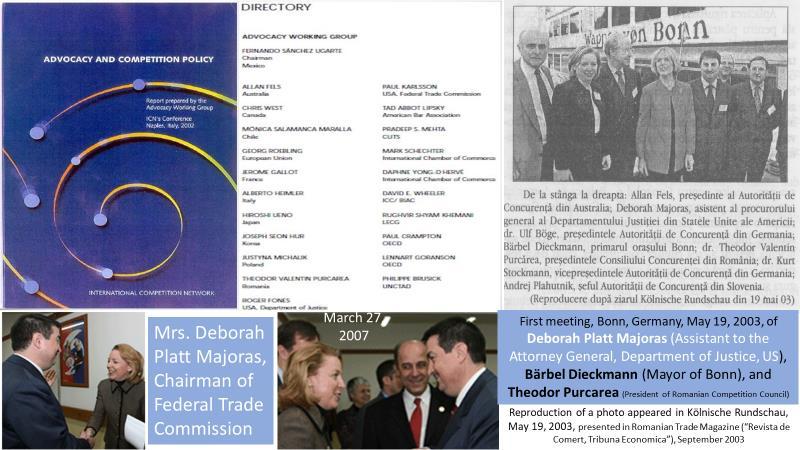

Purcarea, T., 2019. Retailers’ Reinvention in Harmony with the Shopping Tendencies, Romanian Distribution Committee Magazine, vol. 10(2), pp. 36-46, June.
Purcărea, T., Ioan-Franc, V., Ionescu, S.A. and Purcărea, I.M., 2021. The Profound Nature of Linkage Between the Impact of the Use of Artificial Intelligence in Retail on Buying and Consumer Behavior and Consumers’ Perceptions of Artificial Intelligence on the Path to the Next Normal. Amfiteatru Economic, 23(56), pp. 9-32.
Purcărea, T.; Ioan-Franc, V.; Ionescu, Ş.-A.; Purcărea, I.M.; Purcărea, V.L.; Purcărea, I.; Mateescu-Soare, M.C.; Platon, O.-E.; Orzan, A.-O., 2022. Major Shifts in Sustainable Consumer Behavior in Romania and Retailers’ Priorities in Agilely Adapting to It. Sustainability 2022, 14, 1627. https://doi.org/10.3390/su14031627.
Purcarea, T., 2023. Disrupted and Reshaped Global Supply Chains, Marketing Performance, and Marketers’ New Tool ChatGPT and Its Competition, Holistic Marketing Management, vol. 13(1), pages 04-11, February.
Slater, D., n.d. Elements of Amazon’s Day 1 Culture, Amazon Web Services (AWS). [online] Available at: <https://aws.amazon.com/executive-insights/content/how-amazon-defines-and-operationalizes-a-day-1-culture/> [Accessed 1 March 2023].
9
Using Information and Communications Technology Advances to Leverage the Search of the World New Balance with Less Resources -Part 1-
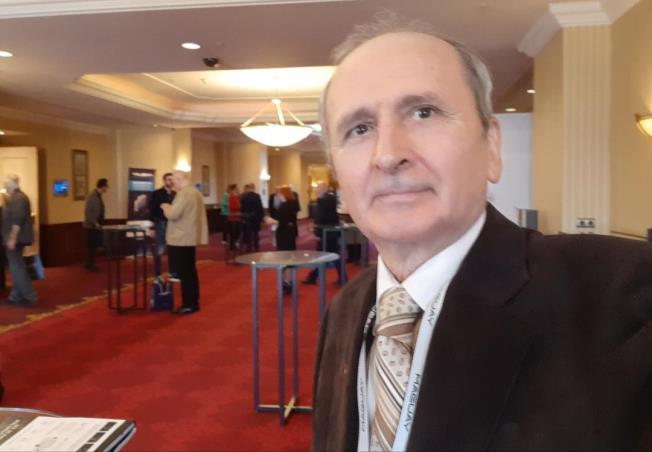
Abstract
The paper analyses the changing and dramatic World context, which determines the premises to be associated with a World new balance with less resources and further the most prominent challenges/requirements/restrictions that should come from the crucial reality of climate changes and global warming along with Earth resources fading. New types of performances, which eventually should be associated with a World new balance with less resources, will be more relevant, at Earth ecosystem scale, than, for example, the usual/technical performances of information and communications technology (ICT) or any industry or human activity field (here the Earth resources should include at least energy and materials, either natural, fossil or created by man, although other subsequent or subtle categories should be added). Generally, identifying the new balance goals, like appropriate optimized solutions, is perhaps the most difficult part, because, from the start, here we could find an extremely complex and complicate problem, even if we put it in a concrete area of ICT (for example artificial intelligence - AI) or other industry, amplified by the new restrictions and uncertainties induced in the changing and dramatic World context. More than these, the new restrictions and uncertainties could come from multi-criteria analyses, including the expected/necessary changes in human behaviours, like consumption or rational use of Earth resources.
Our approach idea is to reconsider and refine knowledge about the fact that now all the known/old negative trends of Earth ecosystem meet the unprecedented critical/crucial stages/levels which the climate changes and Earth resources fading have reached. In physical terms, but with certain obvious limits, this evaluation is similar with the superposition of effects, leading this way to new concrete/value results. Further, such results could be, in fact, higher or even catastrophic, if not known and prevented. The paper goal is still to consider, now and here, starting from unprecedented loses of lives, energy and materials, the impact of ICT on managing/supporting the research of survival solutions for the emerging crises of energy and materials, still noting that, in fact, the human lives are prominent and more, the expected solutions will leverage saving eventually more lives on Earth.
It is worth to recall the link between fossils energy sources, materials and climate changes, as it is largely agreed that the carbon footprint of old technologies of producing energy or materials, along with their use, including transportation industries pollution, are major causes of global warming.
More than these, by using less resources, in the actual dramatic World context, we have to understand that, beyond fossil energy sources or diverse materials, the sustainable new World balance has to include changes of paradigms about consumption and efficiency in general. This could also mean new behaviours about using anything, as long as almost anything we could use/act contains energy and materials (even human effort!), including new (non fossil) energy and materials resources.
Consequently, we have to use less resources not only because they are limited and more expensive, but inherently they could contribute, in diverse ways, to global warming or Earth resources fading. Perhaps this is why we hear today, more often than yesterday, that “the World will be no more what it was”. For a confirmation of the realism about the actual Earth context evaluation, although only just for a starting point with simple issues, the IEEE prestige and potential was considered, by analysing some of their solutions proposals on mitigating global warming, at the COP27 event held in Egypt in November 2022. Because the ICT potential is beyond just approaching dramatical challenges and complexity, but, by its advances, it could ease research and find solutions in all human activity areas where inherently the ICT impact is spread at planetary scale, we also analysed another relevant example providing a systemic approach, the Industrial Internet of Things, due to the emerging advances of IoT at Earth scale and to its benefic penetration into all industries first. Considering one of the most important challenges of IoT exploding proliferation, the security/safety, in practice this will become a very complex and complicate problem along with ICT/World actual context, involving a huge research effort, but with promising results in “healthcare, transportation, manufacturing and mining”, based on adequate” technologies, prototypes, systems, models, methods, and applications”.
Prof. Eng. Ph.D. Victor GREU
10
The remarkable conclusion of the paper first section is that facing the complexity and complication of the actual dramatical World context, even with the ICT instruments advances, is a new level of challenge everywhere, because of the highly dynamic and uncertainty of Earth ecosystem processes, needing deeper timely analyses and even new paradigms to approach it.
The identification and implementation of World new balance with less resources are strongly depending, beyond the Earth natural ecosystem limits, on the complexity which generates their highly dynamic and uncertainty features, where humankind behaviour and evolution are surely basic factors. The traditional “what is best”, people used almost everywhere, now means to consider, as first priority, the Earth resources fading and the mandatory finding of a new balance of all activities with less resources, but also new ways/paradigms of using the known resources (like fossils energy sources and materials) along with the new sustainable alternatives.
One of the subtle, but systemic, contributions of ICT to IS/KBS, beyond products and services, is to lend some of its methods and mechanisms of progress to other areas of human activity [6][9][16]. An actual issue, which is common for ICT/AI advance, but also for World/humankind struggle for a new balance with less resources, is fighting complexity and uncertainty, toward optimizing the World resources and development. We have considered some areas of uncertainty when designing AI as instrument of leveraging the decision processes which could impact the World and generally the humankind future, based on [4] analysis, referring to some usual models and detailed approaches of the basics of AI uncertainty. We have remarked the fundamental difference and correlation between human intelligence (HI) and AI. It is necessary to timely meditate at this AI/HI correlation and its consequences, for both AI potential/future and humankind future [6][9]. Beyond the sophisticated mechanisms of AI and of machine learning (ML), or types of agents they contain, it is important to notice the reflexion of HI features in AI/ML models, which is in fact the territory of continuous improvements for ICT/AI research. Consequently, we have to notice that another feature/challenge of ICT/AI research, also present at HI levels, is the relative separation between risk and ambiguity, as the World processes are very complex and complicate and the transition from known to unknown is the area where ICT/AI have to perform, but sometimes in a vicious circle, in a similar way the refined knowledge is changing, at humankind level, because of the dramatic and dynamic World changes.
As final conclusion, we believe that the reviewed actual World context features require to continue deeper and timely analyses, both for the technical ICT processes and the social/human complex evolutions and challenges, in order to meet useful elements which could leverage the search of solutions for the sustainable identification and implementation of World new balance with less resources.
Keywords: artificial intelligence uncertainty, World new balance, industrial internet of things, refining knowledge, risk and ambiguity, small modular reactors, coal plants, Bayes-optimal agents
JEL Classification: L63; L86; M15; O31; O33
Knowing yourself is the beginning of all wisdom
― Aristotle
1. Information and communications technology approaches contributions to mitigate World’s dramatical challenges
Decade after decade, information and communications technology (ICT) usually impressed us with its amazing and fast advances, while people’s expectations, encouraged by industry trends and politics, have considered this as a traditional picture of the field.
Following this image, a legitim question could be: Is this the right/expected way for the years to come, considering the actual context of dramatic World changes?
Although the answer is not simple, for a realistic approach we should agree that ICT is only the iceberg tip of the science, technologies and industries evolution for decades, as we also presented [18][25][16].
Starting from this well-known prominent position and its crucial role in Information Society (IS) on the way towards the Knowledge Based Society (KBS), as main factor of the World progress, it seems that few things should/could be changed about ICT exponential development.
Still, in the actual context of dramatic World changes, the Earth resources fading, human actual priority expectations and challenges should be deeply analysed and then the resulted refined knowledge further used for driving the entire Earth ecosystem sustainable evolution [3].
On this way, obviously, ICT development and advances, like artificial intelligence (AI) and Internet of Things (IoT), could and should be also reconsidered by the requirements/restrictions of the new, fast changing and dramatic World context.
Naturally, such realistic approach of the dynamic World present and future should bring the expected actions and appropriate optimized solutions, where ICT remains a prominent factor. Consequently, our analyses/papers will follow this approach, keeping in mind the desired role and the potential of ICT.
Thinking, generally, at goals like appropriate optimized solutions, is perhaps the most difficult part, because, from the start, here we could find an extremely complex and complicate problem, even if we put it in a concrete area of ICT (for example AI) or other industry, amplified by the new restrictions and uncertainties induced in the changing and dramatic World context.
In fact, the new types of performances, which eventually should be associated with a
11
World new balance with less resources, will be more relevant, at Earth ecosystem scale, than, for example, the usual/technical performances of any industry or human activity field. Generally, here the Earth resources should include at least energy and materials, either natural, fossil or created by man, although other subsequent or subtle categories should be added [7][8][10][17].
More than these, the new restrictions and uncertainties could come from multi-criteria analyses, including the expected/necessary changes in human behaviours, like consumption or rational use of Earth resources.
Beyond any doubt, the most prominent challenges/requirements/restrictions should come from the crucial reality of climate changes and global warming along with Earth resources fading, as we also presented [18][11]. One of the analyses toughest challenges is the fact that the mentioned multiple criteria are not independent and consequently difficult to be quantified and considered.
Perhaps a dramatic picture of such superposition of causes/effects could be considered while witnessing the horrible destructions of the Russia/Ukraine war or recent Turkey earthquake and thinking, in the same time, but not exclusively, at the above-mentioned climate changes or expected/necessary changes in human behaviours, like consumption or rational use of Earth resources. More than these, the geopolitical/defence implications and trends could add to and complicate this World context.
Although they appear as having less in common, these events and trends inherently reveal the necessity to reconsider the increasing risks for Earth ecosystem and humankind survival, which are generated by the unprecedented losses of lives, energy and materials.
Going further, one could say that “unprecedented” is not the case, as wars and earthquakes were and will probably be again.
Here the point and our approach idea are to reconsider and refine knowledge about the fact that now all the known/old negative trends of Earth ecosystem meet the unprecedented critical/crucial stages/levels which the climate changes and Earth resources fading have reached. In physical terms, but with certain obvious limits, this evaluation is similar with the superposition of effects, leading this way to new concrete/value results. Further, such results could be, in fact, higher or even catastrophic, if not known and prevented.
Unfortunately, such evaluations are far from being simple or linear/physical simulated (see wars and earthquakes), depending on human subjective behaviour/decisions or random physical processes.
Consequently, all analyses should consider studying and mitigating as much as possible such implications/causes of changing and dramatic World context, where human subjective behaviour/decisions are obviously most cases [10][12].
Reviewing the above complicate context, our paper goal is still to consider, now and here, starting from unprecedented losses of lives, energy and materials, the impact of ICT on managing/supporting the research of survival solutions for the emerging crises of energy and materials, still noting that, in fact, the human lives are prominent and more, the expected solutions will leverage saving eventually more lives on Earth.
A crucial reality, on this line, is the link between fossils energy sources, materials and on the other side the climate changes, as it is largely agreed that the carbon footprint of old technologies of producing energy or materials, along with their use, including transportation industries pollution, are major causes of global warming.
More than these, by using less resources, in the actual dramatic World context, we have to understand that, beyond fossil energy sources or diverse materials, the sustainable new World balance has to include changes of paradigms about consumption and efficiency in general. This could also mean new behavioursaboutusinganything,aslongas almostanythingwecould use/actcontainsenergyandmaterials (even human effort!), including new (non fossil) energy and materials resources. Consequently, we have to use less resources not only because they are limited and more expensive, butinherently theycould contribute,in diverse ways,toglobalwarmingorEarthresourcesfading.Perhaps this is why we hear today, more often than yesterday, that “the World will be no more what it was”.
As a confirmation of the realism about the actual Earth context evaluation, although next it is just a starting point with simple issues, the IEEEprestige andpotential are worth tobe considered here,as it is presented by [1]:
“Simple, effective solutions that can help lessen the impact of climate change already exist. Some of them still need to be implemented, though, while others need to be improved. That’s according to 2023 IEEE President Saifur Rahman, who was among the speakers from engineering organizations at the COP27 event held in Egypt in November. The IEEE Life Fellow spoke during a session addressing the role of technology in delivering an equitable, sustainable, and low-carbon resilient world.
Rahman, a power expert and professor of electrical and computer engineering at Virginia Tech, is the former chair of the IEEE ad hoc committee on climate change. The committee was formed last year to coordinate the organization’s response to the global crisis.
12
About one-third of emissions globally are produced through electricity generation, and Rahman said his mission is to help reduce that amount through engineering solutions.
At COP27, he said that even though the first legally binding international treaty on climate change, known as the Paris Agreement, was adopted nearly a decade ago, countries have yet to come to a consensus on how to stop burning fossil fuels, among other issues. Some continue to burn coal, for example, because there are no other economically feasible choices for them.”
As we alreadypresented [21][18],theoptimizationofthe actual complex contextshouldconsider, among others, a proper interpretation of the recent past, including the post Paris Agreement, but adding concrete data like “one-third of emissions globally are produced through electricity generation”, or recalling that ICT global carbon footprint exceeded all air flights and they are fast increasing [11].
The Earth reality is still more complicated than a good intention plan and a mature set of advices is further given:
<< “We as technologists from IEEE say, ‘If you keep to your positions, you’ll never get an agreement,’” he said. “We have come to offer this six-point portfolio of solutions that everybody can live with. We want to be a solution partner so we can have parties at the table to help solve this problem of high carbon emissions globally.”
The solutions Rahman outlined were the use of proven methods that reduce electricity usage, making coal plants more efficient, using hydrogen and other storage solutions, promoting more renewables, installing new types of nuclear reactors, and encouraging cross-border power transfers.>>
Entering technical solutions is, in this case, a concrete step towards the expected improvements, but beyond home simple/known measures as switching to LEDs, which use at least 75 percent less energy than incandescent bulbs, industry scale is approached, as it is detailed for the main proposed fields/advices:
<< Shutting down coal power plants completely is unlikely to happen anytime soon, he predicted, especially since many countries are building new ones that have 40-year life spans. Countries that continue to burn coal should do so in high-efficiency power plants, he said. One type is the ultra supercritical coal-fired steam power plant. Conventional coal-fired plants, which make water boil to generate steam that activates a turbine, have an efficiency of about 38 percent. Ultra supercritical plants operate at temperatures and pressures at which the liquid and gas phases of water coexist in equilibrium. It results in higher efficiencies: about 46 percent. Rahman cited the Eemshaven ultra supercritical plant, in Groningen, Netherlands which was built in 2014. Another efficient option he pointed out is the combined cycle power plant. In its first stage, natural gas is burned in a turbine to make electricity. The heat from the turbine’s exhaust is used to produce steam to turn a turbine in the second stage. The resulting two-stage power plant is at least 25 percent more efficient than a single-stage plant.>>
A crucial premise for sustainable solutions, in the actual and future dramatic/dynamic Word context, is to observe that ideal/single ideas are not suitable and consequently we have to search elaborated and integrating systems:
<<To properly balance electricity supply and demand on the power grid, renewables should be integrated into energy generation, transmission, and distribution systems from the very start, Rahman said. He added that the energy from wind, solar, and hydroelectric plants should be stored in batteries so the electricity generated from them during off-peak hours isn’t wasted but integrated into energy grids. He also said low-cost, low-carbon hydrogen fuel should be considered as part of the renewable energy mix. The fuel can be used to power cars, supply electricity, and heat homes, all with zero carbon emissions.
“Hydrogen would help emerging economies meet their climate goals, lower their costs, and make their energy grid more resilient,” he said.>>
We think that here it is worth to notice a new vision about the old nuclear power, aiming not only a modular solution/implementation, but also considering its unique sustainability feature at Earth scale (carbon neutral by 2050):
<<Rahman conceded there’s a stigma that surrounds nuclear power plants because of accidents at Chernobyl, Fukushima, Three Mile Island, and elsewhere. But, he said, without nuclear power, the concept of becoming carbon neutral by 2050 isn’t realistic.
“It’s not possible in the next 25 years except with nuclear power,” he said. “We don’t have enough solar energy and wind energy.”
Small modular reactors could replace traditional nuclear power plants. SMRs are easier and less expensive to build, and they’re safer than today’s large nuclear plants, Rahman said. Though small, SMRs are powerful. They have an output of up to 300 megawatts of electricity, or about a quarter of the size of today’s typical nuclear plant.
The modular reactors are assembled in factories and shipped to their ultimate location, instead of being built onsite. And unlike traditional nuclear facilities, SMRs don’t need to be located near large bodies of water to handle the waste heat discharge. SMRs have not taken off, Rahman says, because of licensing and technical issues.>>
13
Lastbutnotleast,we havetounderstandthattheactualunprecedentedcritical/crucialstages/levelswhich the climate changes and Earth resources fading have reached need not only integration/cooperation, but also free access to all worldwide results:
<<Rahman emphasized the need for more cross-border power transfers, as few countries have enough electricity to supply to all their citizens. Many countries already do so.
“The United States buys power from Canada. France sells energy to Italy, Spain, and Switzerland,” Rahman said. “The whole world is one grid. You cannot transition from coal to solar and vice versa unless you transfer power back and forth.”… During the conference session, Rahman said an IEEE collection of 7,000 papers related to climate change is accessible from the IEEE Xplore Digital Library. IEEE also launched a website that houses additional resources. None of the solutions IEEE proposed are new or untested, Rahman said, but his goal is to “provide a portfolio of solutions acceptable to and deployable in both the emerging economies and the developed countries which will allow them to sit at the table together and see how much carbon emission can be saved by creative application of already available technologies so that both parties win at the end of the day.”>>
Here we have to point a relevant example of the ways IEEE and generally ICT could contribute, at least by leveraging communication and knowledge sharing, to the World struggle for sustainable solutions to the actual unprecedented challenges at Earth scale, based on international collaboration and solidarity against planetary challenges/dangers, at least in the 12-th hour.
Still, the ICT potential is beyond just approaching dramatical challenges and complexity, as it could, by its advances, to ease research and find solutions in all human activity areas where inherently the ICT impact is spread at planetary scale.
A relevant example, providing a systemic approach, is Industrial Internet of Things, due to the emerging advances of IoT at Earth scale and to its benefic penetration into all industries first, as it is also presented by [2]:
“Industrial Internet of Things (IIoT) aims to achieve higher operational and management efficiencies by bridging machinery, equipment, human resources, and all other actors involved in an industrial environment. This bridging enables data flow over an often complex and heterogeneous communication network. It enables timely decision-making, which affects various aspects of the organization such as business, operations, maintenance, safety, stock, and logistics.”
As it is well known, one of the most important challenges of IoT exploding proliferation is the security/safety, which in practice will become a very complex and complicate problem along with ICT/World actual context, involving a huge research effort, as, summary, further mentioned:
“Industrial safety, especially whenever it is intertwined with the safety of humans, is a critical domain and holds much scope for improvement in the context of IIoT-based solutions for industrial safety management. … Subsequently, we classify and provide an in-depth analysis of the safety aspects in various application areas of IIoT such as healthcare, transportation, manufacturing, and mining. … We discuss diverse forms of technologies, prototypes, systems, models, methods, and applications to ensure the safety of individuals and the risks associated with them.”
Facing the complexity and complication of the actual dramatical World context, even with the ICT instruments advances, is a new level of challenge everywhere, because of the highly dynamic and uncertainty of Earth ecosystem processes, needing deeper timely analyses and even new paradigms to approach it
2. Fighting complexity and uncertainty by ICT, toward optimizing the World resources
Perhaps the most important problem of the processes which aim the identification and implementation of World new balance with less resources, is, after the Earth natural ecosystem limits, the complexity which generates their highly dynamic and uncertainty features, where humankind behaviours and evolution are surely basic factors.
Considering the new challenges/crises, the complexity and the progressive complication of World context, along with deeper timely analyses, new paradigms to approach the Earth ecosystem processes are needed everywhere the traditional approaches are no more efficient or efficacious [22][19][15][14].
The unprecedented difficulties of deciding what is best for a holistic approach of World evolution increase the role of ICT advances, like AI, IoT and Big Data, as we have already presented [13][24].
Here we have to point, from the beginning, that the traditional “what is best”, people used almost everywhere, now means to consider, as first priority, theEarth resources fading and the mandatory finding of a new balance of all activities with less resources, but also new ways/paradigms of using the known resources (like fossils energy sources and materials) along with the new sustainable alternatives.
A further step is, naturally, to learn how ICT have to evolve in order to reach the expected results/instruments, considering, of course, the same challenges/crises, complexity and progressive complication of World context impacting ICT advances.
14
As we have repeatedly mentioned, one of the subtle, but systemic, contributions of ICT to IS/KBS, beyond products and services, is to lend some of its methods and mechanisms of progress to other areas of human activity [6][9][16].
This way we have just arrived at the core of an actual issue, which is common for ICT/AI advance, but also for World/humankind struggle for a new balance with less resources, i.e., fighting complexity and uncertainty, toward optimizing the World resources and development.
A more concrete image of this issue is also given by analysing some areas of uncertainty when designing AI as instrument of leveraging the decision processes which could impact the World and generally the humankind future [4]:
“The power of AI comes with a lot of responsibilities. It has changed a lot about our world, but the change has been a double-edged sword. It is responsible for a lot of progress, but some risks and unknowns are involved in its use. Because of this duality, most business leaders are unsure how to use and deploy AI systems. Still, they can look to public agencies that have already experienced these uncertainties in AI initiatives for some answers.”
The areas of AI uncertainty are generally large and dynamic, along with the World context evolution, but, basically, some usual model’s further consideration could be useful:
“… Queensland University of Technology has engaged in around 40 projects that deal with AI efforts in the public, private, and non-profit sectors in Australasia and the United States. However, most of the recommendations were drawn from the public sector. This experience allowed them to observe managers’ use of AI first hand, and they found five major areas of uncertainty.”
Among these areas, communicating realistic expectations and assessing how AI fits tasks proved to be very important:
“From these projects, the team found that managers weren’t sure about the outcome of AI initiatives, and there were four main ways they thought about AI:
AI is overhyped
AI can fully automate tasks
No opinion
AI isn’t perfect, but it is getting better every day
The last group has the right idea. Skill training and accountability were the best way to gain support from the first three groups. This education needs to begin with communicating what AI can accomplish and what it can’t…Managers struggled with evaluating how AI fits into their business. It is the degree of discretion that determines how to fit AI into a task. Repetitive, low-level tasks like data entry or facilities operation are examples of a low-discretion take suitable for total automation.”
The World complexity is unfortunately increasing faster than the analyses could follow and consequently much scientific research effort is needed, leading to detailed approaches of the basics of AI uncertainty, as it is also presented by [5]:
“Reasoning about uncertainty is a hallmark of human intelligence. In artificial intelligence, handling uncertainty is critical for developing systems that act rationally and safely. Such systems should know when to be cautious and avoid catastrophic events, and when to take risks to reap greater benefits.”
Here it is worth to remark, from the beginning, the fundamental difference and correlation between human intelligence (HI) and AI.
We consider that, beyond the phrase context, we have to timely meditate at this AI/HI correlation and its consequences, for both AI potential/future and …humankind future [6][9].
Anyway, the World reality is further presented in the basic terms of AI uncertainty, which could lead to practical approaches for its mitigation when designing the future AI systems:
„But uncertainty comes in different flavours. The economist Frank H. Knight [1] proposed a subtle but important distinction between two fundamental types of uncertainty in decision-making, risk and ambiguity. Risk (i.e., known or closed-world uncertainty) applies to familiar situations where the exact outcome of an event is uncertain but probabilities can be computed, as in roulette wheels and dice. Knowing the probabilities over outcomes enables reducing randomness to effective certainty (e.g. via computing certainty equivalents). In contrast, ambiguity (i.e., unknown or open-world uncertainty) refers to the uncertainty in unfamiliar situations where the probabilities are not known or cannot be determined, e.g., whether in six years the US president will be a Democrat …”
The implementation of the mentioned practical approaches has still a long way ahead, as here it is further explained the model to be next studied for future AI applications:
“Bayes-optimal agents are risk-neutral, since they solely attune to the expected return, and ambiguity-neutral, since they act in new situations as if the uncertainty were known. This is in contrast to risk-sensitive agents, which additionally exploit the higher-order moments of the return, and ambiguity-sensitive agents, which act differently when recognizing situations in which they lack knowledge. Humans are also known to be averse to ambiguity and sensitive to risk in ways that aren’t Bayes-optimal, indicating that such sensitivity can confer advantages,
15
especially in safety-critical situations. How can we extend the meta-learning protocol to generate risk- and ambiguity-sensitive agents? ... by showing that risk- and ambiguity-sensitivity also emerge as the result of an optimization problem using modified meta-training algorithms, which manipulate the experience-generation process of the learner. We empirically test our proposed metatraining algorithms on agents exposed to foundational classes of decision-making experiments and demonstrate that they become sensitive to risk and ambiguity.”
Beyond the sophisticated mechanisms of AI and of machine learning (ML), or types of agents they contain, it is easy to observe here the reflexion of HI features in AI/ML models, which is in fact the territory of continuous improvements for ICT/AI research
More than these, we have to notice that another feature/challenge of ICT/AI research, also present at HI levels, is the relative separation between risk and ambiguity, as the World processes are very complex and complicate and the transition from known to unknown is the area where ICT/AI have to perform, but sometimes in a vicious circle, in a similar way the refined knowledge is changing, at humankind level, because of the dramatic and dynamic World changes.
These are actual World context features that require to continue deeper and timely analyses, both for the technical ICT processes and the social/human complex evolutions and challenges, in order to meet useful elements which could leverage the search of solutions for the sustainable identification and implementation of World new balance with less resources.
3. Conclusions
Although these analyses need to be further continued, some conclusions will point the most important ideas of the above analysed issues.
The new types of performances, which eventually should be associated with a World new balance with less resources, will be more relevant, at Earth ecosystem scale, than, for example, the usual/technical performances of any industry or human activity field (here the Earth resources should include at least energy and materials, either natural, fossil or created by man, although other subsequent or subtle categories should be added).
Thinking, generally, the new balance goals like appropriate optimized solutions, is perhaps the most difficult part, because, from the start, here we could find an extremely complex and complicate problem, even if we put it in a concrete area of ICT (for example AI) or other industry, amplified by the new restrictions and uncertainties induced in the changing and dramatic World context. More than these, the new restrictions and uncertainties could come from multi-criteria analyses, including the expected/necessary changes in human behaviours, like consumption or rational use of Earth resources.
Beyond any doubt, the most prominent challenges/requirements/restrictions should come from the crucial reality of climate changes and global warming along with Earth resources fading, as we also presented [18][11]. One of the analyses toughest challenges is the fact that the mentioned multiple criteria are not independent and consequently difficult to be quantified and considered. A dramatic picture of such superposition of causes/effects could be considered while witnessing the horrible destructions of the Russia/Ukraine war or recent Turkey earthquake and thinking, in the same time, but not exclusively, at the above-mentioned climate changes or expected/necessary changes in human behaviours, like consumption or rational use of Earth resources. More than these, the geopolitical/defence implications and trends could add to and complicate this World context. Although they appear as having less in common, these events and trends inherently reveal the necessity to reconsider the increasing risks for Earth ecosystem and humankind survival, which are generated by the unprecedented losses of lives, energy and materials.
About “unprecedented losses”, our approach idea is to reconsider and refine knowledge about the fact that now all the known/old negative trends of Earth ecosystem meet the unprecedented critical/crucial stages/levels which the climate changes and Earth resources fading have reached. In physical terms, but with certain obvious limits, this evaluation is similar with the superposition of effects, leading this way to new concrete/value results. Further, such results could be, in fact, higher or even catastrophic, if not known and prevented.
Unfortunately, such evaluations are far from being simple or linear/physical simulated (see wars and earthquakes), depending on human subjective behaviour/decisions or random physical processes. Consequently, all analyses should consider studying and mitigating as much as possible such implications/causes of changing and dramatic World context, where human subjective behaviour/decisions are obviously most cases.
Referring to this complicate context, our paper goal is still to consider, now and here, starting from unprecedented losses of lives, energy and materials, the impact of ICT on managing/supporting the research of survival solutions for the emerging crises of energy and materials, still noting that, in fact, the human lives are prominent and more, the expected solutions will leverage saving eventually more lives on Earth.
16
It is worth to recall the link between fossils energy sources, materials and climate changes, as it is largely agreed that the carbon footprint of old technologies of producing energy or materials, along with their use, including transportation industries pollution, are major causes of global warming
More than these, by using less resources, in the actual dramatic World context, we have to understand that, beyond fossil energy sources or diverse materials, the sustainable new World balance has to include changes of paradigms about consumption and efficiency in general. This could also mean new behavioursaboutusinganything,aslongas almostanythingwecould use/actcontainsenergyandmaterials (even human effort!), including new (non fossil) energy and materials resources.
Consequently, we have to use less resources not only because they are limited and more expensive, butinherently theycould contribute,in diverse ways,toglobalwarmingorEarthresourcesfading.Perhaps this is why we hear today, more often than yesterday, that “the World will be no more what it was”.
For a confirmation of the realism about the actual Earth context evaluation, although only just for a starting point with simple issues, the IEEE prestige and potential was considered, by analysing some of their solutions proposals on mitigating global warming, at the COP27 event held in Egypt in November 2022 (“reduce electricity usage, making coal plants more efficient, using hydrogen and other storage solutions, promoting more renewables, installing new types of nuclear reactors, and encouraging cross-border power transfers”)
As the ICT potential is beyond just approaching dramatical challenges and complexity, but, by its advances, it could ease research and find solutions in all human activity areas where inherently the ICT impact is spread at planetary scale, we also analysed another relevant example providing a systemic approach, the Industrial Internet of Things, due to the emerging advances of IoT at Earth scale and to its benefic penetration into all industries first. Considering one of the most important challenges of IoT exploding proliferation, the security/safety, in practice this will become a very complex and complicate problem along with ICT/World actual context, involving a huge research effort, but with promising results in “healthcare, transportation, manufacturing and mining”, based on adequate” technologies, prototypes, systems, models, methods, and applications”.
A remarkable conclusion of the paper first section was that facing the complexity and complication of the actual dramatical World context, even with the ICT instruments advances, is a new level of challenge everywhere, because of the highly dynamic and uncertainty of Earth ecosystem processes, needing deeper timely analyses and even new paradigms to approach it.
Aiming the identification and implementation of World new balance with less resources, is strongly depending, beyond the Earth natural ecosystem limits, on the complexity which generates their highly dynamic and uncertainty features, where humankind behaviour and evolution are surely basic factors.
The unprecedented difficulties of deciding what is best for a holistic approach of World evolution increase the role of ICT advances, like AI, IoT and Big Data, as we have already presented [13][24].
The traditional “what is best”, people used almost everywhere, now means to consider, as first priority, the Earth resources fading and the mandatory finding of a new balance of all activities with less resources, but also new ways/paradigms of using the known resources (like fossils energy sources and materials) along with the new sustainable alternatives.
One of the subtle, but systemic, contributions of ICT to IS/KBS, beyond products and services, is to lend some of its methods and mechanisms of progress to other areas of human activity [6][9][16]. An actual issue, which is common for ICT/AI advance, but also for World/humankind struggle for a new balance with less resources, is fighting complexity and uncertainty, toward optimizing the World resources and development.
We have considered some areas of uncertainty when designing AI as instrument of leveraging the decision processes which could impact the World and generally the humankind future, based on [4] analysis, referring to some usual models and detailed approaches of the basics of AI uncertainty. Here it is worth to remark the fundamental difference and correlation between human intelligence (HI) and AI. We have to timely meditate at this AI/HI correlation and its consequences, for both AI potential/future and …humankind future [6][9]. Beyond the sophisticated mechanisms of AI and of machine learning (ML), or types of agents they contain, it is important to notice the reflexion of HI features in AI/ML models, which is in fact the territory of continuous improvements for ICT/AI research. Consequently, we have to notice that another feature/challenge of ICT/AI research, also present at HI levels, is the relative separation between risk and ambiguity, as the World processes are very complex and complicate and the transition from known to unknown istheareawhereICT/AIhavetoperform,butsometimesinaviciouscircle,inasimilarwaytherefinedknowledge is changing, at humankind level, because of the dramatic and dynamic World changes.
Finally, we believe that the reviewed actual World context features require to continue deeper and timely analyses, both for the technical ICT processes and the social/human complex evolutions and challenges, in order to meet useful elements which could leverage the search of solutions for the sustainable identification and implementation of World new balance with less resources.
17
REFERENCES
[1]Kathy Pretz, IEEE Discusses 6 Simple Solutions to Climate Change at COP27, IEEE Spectrum -The Institute, Jan 2023, https://spectrum.ieee.org/6-solutions-to-climate-change?utm_source=feedotter&utm_medium=email&utm_campaign=theinstitutealert020723&mkt_tok=NzU2LUdQSC04OTkAAAGJydzxSHpuq5OM3DCG1vf09lo7cS9SF4diBorTarLno1KsPH DxoBUdWtlSl7n1JnvJxzsuSpD5nTSp4emRYFU-PhQVmCqj5VigYPQwsBCo
[2]Sudip Misra, Chandana Roy, Thilo Sauter, Anandarup Mukherjee, Jhareswar Maiti, Industrial Internet of Things for Safety Management Applications: A Survey, IEEE Access ( IF 3.476 ) Pub Date: 2022-07-27, https://www.x-mol.net/paper/detail/1566136228154413056
[3]Victor Greu, Developing information and communications technology to provide more intelligence and leverage more wisdom for a dramatically changing World -(Part 2), Romanian Distribution Committee (affiliated to the “International Association of the Distributive Trade”-scientificassociation – A.I.D.A. Brussels) Magazine(international; electronic; covered in RePEc International Data Base), Volume13, Issue 2, Year 2022.
[4]***, Strategies to Tackle Uncertainty With AI Deployment, Computer Society Team, 12/19/2022, https://www.computer.org/publications/tech-news/research/strategies-to-tackle-uncertainty-with-ai-deployment
[5]Jordi Grau-Moya et all, Beyond Bayes-optimality: meta-learning what you know you don’t know, Technical Report 2022-10-13, https://arxiv.org/pdf/2209.15618.pdf
[6]Florin Enache, Victor Greu, Petrică Ciotîrnae, Florin Popescu, Model and Algorithms for Optimizing a HumanComputing System Oriented to Knowledge Extraction by Use of Crowdsourcing, 2020, 13th International Conference on Communications (COMM), (Politehnica University of Bucharest, Military Technical Academy, IEEE Romania), (COMM 2020 is covered in IEEE Explore Database and ISI Web of Science in the Conference Proceedings Citation Index)
[7]Maria Gallucci, The Ammonia Solution, IEEE Spectrum, Volume 58, Issue 3, March, 2021
[8]Michelle Hampson, This RISC-V Powerhouse Goes Light on the Power, Volume: 59, Issue: 1 Jan 2022
[9]Victor Greu et all, Human and artificial intelligence driven incentive-operation model and algorithms for a multi-purpose integrated crowdsensing-crowdsourcing scalable system, Proceedings of International Conference Communications 2018, (Politehnica University of Bucharest, Military Technical Academy, IEEE Romania), June 2018(COMM 2018 is covered in IEEE Explore Database and ISI Web of Science in the Conference Proceedings Citation Index)
[10]Raj Kumar Hansdah, Scientific Progress Without True Wisdom Will Cause More Harm Than Good, https://www.beaninspirer.com/scientific-progress-without-true-wisdom-will-cause-more-harm-than-good, Updated: October 21, 2021
[11]Victor Greu, Information and communications technologies go greener beyond IOTbehind is all the earth-Part1, Romanian Distribution Committee (affiliated to the “International Association of the Distributive Trade”scientific association – A.I.D.A. Brussels) Magazine(international; electronic; covered in RePEc International Data Base), Volume 7, Issue 2, Year 2016.
[12]Giuliano Punzo et al, Engineering Resilient Complex Systems: The Necessary Shift Toward Complexity Science, IEEE SYSTEMS JOURNAL, VOL. 14, NO. 3, SEPTEMBER 2020
[13]Victor Greu, Information and communications technology is merging data science and advanced artificial intelligence towards the core of knowledge based society -(Part 3), Romanian Distribution Committee (affiliated to the “International Association of the Distributive Trade”-scientificassociation – A.I.D.A. Brussels) Magazine(international; electronic; covered in RePEc International Data Base), Volume12, Issue 3, Year 2021.
[14]Samuel K. Moore, How and When the Chip Shortage Will End, IEEE Spectrum, Volume: 58, Issue: 6, Jun 2021
[15]Srividya K. Bansal, Sebastian Kagemann, Semantic Extract-Transform-Load framework for Big Data Integration, Computer, Volume: 48, Issue: 3, Mar. 2015
[16]Victor GREU, Information and Communications Technologies are Learning from Nature’s “Research” to Push the Performance Limits, Romanian Distribution Committee (affiliated to the “International Association of the Distributive Trade”-scientificassociation – A.I.D.A. Brussels)Magazine(international;electronic; covered in RePEc International Data Base), Volume 5, Issue 1, Year 2014.
[17]Robert W. Lucky, Deep Complexities in EE, IEEE Spectrum, May 2018
[18]Victor Greu, Searching the right tracks of new technologies in the earth race for a balance between progress and survival, Romanian Distribution Committee (affiliated to the “International Association of the Distributive Trade”-scientific association – A.I.D.A. Brussels) Magazine(international; electronic; covered in RePEc International Data Base), Volume 3, Issue1, Year 2012.
[19]Ernesto Villalba, The Concept of Knowledge for a Knowledge-based Society From knowledge to learning, European Commission Joint Research Centre © European Communities, 2007
[20] Victor Greu, Communicate on … Communications - From a Conference every 2 years to the need to communicate everyday and everywhere, Romanian Distribution Committee (affiliated to the “International Association of the Distributive Trade”-scientific association – A.I.D.A. Brussels) Magazine (international; electronic; covered in RePEc International Data Base), Volume 5, Issue 2, Year 2014.
[21]Victor Greu, The information and communications technology is driving artificial intelligence to leverage refined knowledge for the World sustainable development –(Part 2), Romanian Distribution Committee (affiliated to the “International Association of the Distributive Trade”-scientific association –A.I.D.A. Brussels) Magazine(international; electronic; covered in RePEc International Data Base), Volume 10, Issue 1, Year 2019.
[22]Andreas Poltermann, Education for a Knowledge-Based Society? A Concept Must be Rethought, 17 April 2014, https://rs.boell.org/en/2014/04/17/education-knowledge-based-society-concept-must-be-rethought
[24]Victor Greu, Using the information and communications technology data deluge from a semantic perspective of a dynamic challenge: What to learn and what to ignore?
(Part 2), Romanian Distribution Committee (affiliated to the “International Association of the Distributive Trade”-scientific association –A.I.D.A. Brussels) Magazine(international; electronic; covered in RePEc International Data Base), Volume 10, Issue 4, Year 2019.
[25] Victor Greu, Context-aware communications and IT – a new paradigm for the optimization of the information society towards the knowledge-basedsociety(Part2),Romanian Distribution Committee (affiliated to the “International Association of the Distributive Trade”scientific association
A.I.D.A. Brussels) Magazine (international; electronic; covered in RePEc International Data Base), Volume 5, Issue4, Year 2014.
–
–
18
Abstract
The Driving Forces of M-Commerce as an Emerging Technology and Independent Ecosystem
 by Cosmin TĂNASE
by Cosmin TĂNASE
With the advancement in technology and the introduction of internet, the traditional electronic data interchange (EDI) has transformed to internet dependent commerce, electronic commerce (e-commerce). E-commerce has enabled users to access services and make transactions from anywhere and anytime. Nowadays e-commerce is continuously moving towards mobile commerce (m-commerce). M-commerce is not an extension of e-commerce but it is a new dimension in the era of new-age marketing. M-commerce has created a new definition in modern-day marketing. It has set new parameters and designed a path for marketing revolution in the future. The ease, comfort, accessibility, and convenience have broadened the outlook of the participants in the industry and widened the scope of business. Driving forces for m-commerce are the factors which will lead to expansion of the technology to a wider market segment. It will help the companies to walk toward a new technological revolution. It will lead to a better connectivity between buyers and sellers, connectivity which will also encompass Business to Business, (B2B), Business to Consumer (B2C), Consumer to Business (C2B), and Consumer to Consumer (C2C). M-commerce provides customers’ comfort, convenience, and cost-effective ways to fulfill their requirements. It also leads to better linkage between the buyers and sellers.
Keywords: Mobile payments, Software, E-commerce, Technology, Transactions, Connectivity, Customers
JEL Classification: C88; D83; M31; M37; O33
M-commerce can be defined as the wireless mode by which buying and selling can be undertaken. The transactions are held through wireless medium without any need for plugging in. the technology provides the comfort and convenience to the users. Mobile communication is a device which stands apart from all the historical communication methods. It is a new chapter and has set multidimensional parameters. Mobile is considered to be most powerful medium of communication.
Technology has reached at a very fast rate to every stratum and segment of the world. It has superseded all the demographical, geographical, or sociological boundaries in the world. Mobile has in true sense led to technological inclusion. It has incorporated each and every individual under its ambit. This technology has created platforms for sharing of knowledge, expression, ideas, and innovations and is building awareness among the masses. There is no
19
rocket science to get adapted to this great technology. It is user friendly, accommodating, economical, and has bypassed all the barriers of communication. A technology which provides solution to all communication deterrents, language barriers, and above all, it wins over all the special needs. The latest software’s have incorporated the demands of the people born with special needs. The technology is not only supporting them but also complementing their requirements. People with different learning disabilities can make use of the technology and a large number of apps, which instill confidence in their abilities.
COMPONENTS OF M-COMMERCE
The financial components of m-commerce include mobile banking, mobile financial services, and mobile payment. M-commerce also includes transportation services, gaming services, household services, house-help services, online groceries, and so on. Mobile technology has been so far successful with the convenience of carrying on all buying and selling activities comprising anything from anywhere, without the need of the usage of desktop. The extension of m-commerce should encompass all the commerce and business transactions to be carried on the internet. Mcommerce applications should be user friendly providing the ease and convenience to its users. Mobile financial services are an inherent contributory factor for the success of m-commerce.
Financial services include the money transfer, banking transactions, payment of insurance premium and mutual fund payments, and so on. Mobile payments comprise payment for the usage of services online through application-based services by transferring the funds from the online bank accounts to the mobile payment wallet. Such as if a person has used the online cab service, the payment for the same can be done from the bank account directly to the service providers account through the mobile without the need for carrying cash. Growing demand for mobile banking has created large number of opportunities for the banks to target the account holders for providing mobile banking services. It provides ease and comfort of getting the information related to the banking transactions with respect to your account. Mobile financial services need a large amount of security or an enhanced finger recognition system so as to provide authenticity and thus, increasing the number of users.
When all the financial transactions can be handled through the mobile, it provides convenience as well as the comfort of handling the financial transactions. The 24/7 access to the account is considered to be a safe option. In case of any emergency, the customer will not have to wait for the next day for branch to open to know the robbery or a fraud from his account. The earlier information will lead the account holder to keep himself abreast of transaction on his account. M-commerce provides an opportunity to banks to target their tech-savvy customers and be in constant touch with them by providing variety of schemes and offers. Banks can also reach to new customers by offering technology as a strong point and the efforts taken at their end to ensure safety and security as front-end parameters. Mobile banking could have a brighter future as compared to online banking, if the banks and their technology departments can upgrade and implement the high-end skills to reach out to customers in every possible way. M-commerce requires safety and security as strong phenomena. It also needs the innovative strategies to beat the tough competitive wars and create retention among the existing users. Cost-effective plans can be a possible tool to attract new customers as well.
EXTENSION OF E-COMMERCE. The rise of e-commerce has led to the progress toward m-commerce. Technological revolutions have created a push toward ease and convenience in the most cost-effective manner. Internet access and web browsing on mobiles have become an inseparable part of mobile. Mobiles come with an added advantage of touch screen technology, which makes it easy to handle anywhere and anytime. It also incorporates all the comforts and conveniences satisfying the needs of the consumers. Changes in the technology have given the m-commerce world a better push and a great support to carry on transactions more smoothly. One of the important driving forces for the m-commerce technology is the easy access of internet on mobiles. Consumers are happy to enjoy the merging of two technologies at the top of communication world mobile and internet. When internet is offered free on mobile, they are willing to make use of it. But a great resistance is shown toward the payments involved in the usage of internet services still by a large number of users. M-commerce is an extension of e-commerce with the provision of using of a large number of apps without the need for a desktop. Customers should be presented with the ideology of a brand-new medium in the m-commerce technology. The participants of mcommerce technology have to develop a change in the thinking abilities and a shift in their approach while using this technology. The m-commerce technology has to imbibe the needs and desires of the consumers, marketers, and all the other authorities participating. M-commerce and e-commerce should be considered as two different tools in the technological inventions. Their roles have to be categorized and understood in isolation. They both vary with their
20
own advantages and disadvantages. The three main drivers of m-commerce are value chain, technology, and consumer demand, which are the main reasons contributing for the mass revolution this type of commerce.
COST. The cost is higher due to the network and other associated systems. The investment rises as it has to be made available while the customer is on move. Cost also depends on the data usage, downloads, files accessed, and the services provided. Mobile communication companies have tried to lure consumers by providing free internet usage on mobiles. It has proven a good amount of success for them at the initial stage since the number of people opting for the communication services has considerably risen up. But the big question would be that something which was freely available all this while, will it still be popular when the cost factor is added to it. Marketers have understood the fact that the two binaries, that is, mobile and internet are now inseparable from the consumers. In fact, they are more of an addiction for the consumers. The service which was coming free to them for a period of 6 months, customers might will pay a small fee for it rather than forgo the usage of internet addiction which they cannot imagine living without. Pricing strategies should be carefully drafted and efficiently delivered, without the consumer realizing the burden of it. The consumers should feel excited about the brand which they have accessed for this while without paying any charges and a nominal fee might be just a token of appreciation for them to repay.
SOCIAL MEDIA MARKETING. Entertainment industry is a big industry and growing leaps and bounds. Mobile communication systems have changed the entertainment industry as well. Movies can be downloaded, TV serials could be uploaded, movie tickets could be booked online, and utility payments could be made. Mobiles have provided convenience, comfort, and above all, it has caused enormous changes in the business dynamics. Mobile marketing and mobile ticketing are the two terms which have got added in the mobile revolution. Music, movies, TV serials, games, and so on, mobile technology provides a wider range of entertainment services to its users. The technology aims to provide 24/7 entertainment channel to the consumers in the form of mobile, the one of major drivers for the China’s mobile economic boom. It is an entertainment outlet which is not dependent on indoor connectivity but also extends to outdoors through a wireless medium. It is available everywhere, with or without internet connectivity. Mobile entertainment also covers videos and audio messages which are travelling through the reins of social media. They are reaching out to a larger number of audiences. Audio and videos once downloaded on the mobiles can be listened and watched any number of times without the requirement of any kind of connectivity or services. Mobile entertainment services provide mobility, which helps during travelling, vacations, or out of station. These services are very helpful for the users to fulfill their leisure requirements. Social media has created impetus in the spread of mobile entertainment. Real or unreal videos keep on getting uploaded on the mobiles and the users ensure the video gets viral faster than any mode of communication.
DRIVING FORCES FOR M-COMMERCE
Mobile applications have been a boom for all the businesses. Every business organization establishes a mobile application to provide services in the viral world. Technology aspires to be accessible all the time. The generations of today, no more waits to log on to the desktop or a laptop. The handiest option is a mobile. Whether it is making payments, transferring of funds, shopping, ordering goods, or any other online transaction, the fastest mode is mobile. Mobile technology, due to its ease, accessibility, and convenience has taken over all the other electronic and other gazettes from us. Whether it is a diary, calendar, clock, alarm, calculator, camera, Walkman, radio, albums, newspapers, or contacts collection, it has taken over almost every other thing. The mode of communication now remains mobile, whether through chat, messenger, mails, social media, video calling, or anything else. Medium of communication for today’s generation is largely mobile; therefore, a vast amount of time is spent on it. Marketers realized that to survive the tough marketing warfare, they have to have mobile advertising as an important element of IMC, that is, Integrated Marketing Communication. It has changed our lives, the way we communicate, travel, chat, explore, shop, order, express, celebrate, wish, and handle our relationships. The new social quotient formulas are derived from the number of Facebook friends, Twitter followers, WhatsApp groups, and so on. Social circles are getting viral with the clubs evolving in it, in the form of WhatsApp groups. Psychological satisfaction is now defined by the number of likes, comments on Facebook, comments on Instagram, and comments posted on walls of social media. The changing times have changed the era of communication, the way we express, share, or post anything. The words are replaced now by emoticons available aptly for each and every possible situation. Recent changes in the business environment have brought immense changes in the marketing strategies and have streamlined broader business definitions.
• COMPETITION - Three main organic objectives of business are survival, growth, and image. These organic threefold objectives have articulated the businesses to strategize their marketing policies. Marketing warfare has set
21
new boundaries in the industry. Competition among the brands is omnipresent. The cutthroat competition has crossed all the boundaries and parameters of doing businesses. Every other brand strives for retention and creating reminders in the minds of the customers. Therefore, there is a dire need to be where the customers are, that is, the world of mobiles. Resultantly, most of the brands have created and placed their applications online. In fact, they have gone a step further to motivate the consumers to download the app by luring them to attractive offers, ranging from initial free orders, discounts, or fee waivers. Consumers have to download the app on their mobiles and the services begin along with the monetary incentives.
• TECHNOLOGY - Advancements in technology have created a new era in the world of marketing and advertising. Brands are vying for consumer’s attention by all means. On one hand, high-end technology has created innumerable opportunities for the brands to make their products and services accessible and believable for the consumers but on the other hand, technology also brings resistance from the users. Technology works all the ways whether it is to involve the customers in the production process or at any other stage of delivery of product. It leads to providing products to customers, especially customized ones by fitting in their desires and expectations. Technology has made possible a delivery system which has never been imagined before, while ensuring that the products and services are being rendered in most shortened time frame. It is an era where the physical delivery of goods could be virtually tracked and exact delivery time can be estimated. The app world makes it easier for the marketers to be available to the customers 24/7. It makes the concept of accessibility and convenience true in the real-time frame. It wins over the barriers of geography as well as demography. The markets are widened when the expansion takes place and the consumer base increases.
• GLOBAL VILLAGE - In the current scenario, the world is one big stage with all kinds of products in a big market inclusive of buyers and sellers. The challenge lies for the developing nations, as they have to meet the standards laid by the developed nations. The world is walking on the lanes of cutthroat technology. Every nation and every other company have to imbibe and inculcate the technological advancements in its functioning behavior. Global village has on one hand provided immense opportunities to marketers by creating wider markets. On the other hand, it has laid m-commerce as a challenge. Emerging markets are opportunities in front of the marketers all over the world to be grabbed. They have the advantage of selling the goods to the customers all over the world without any kind of geographical barriers. The wider markets have enhanced the scope of their businesses. Mcommerce is an opportunity which stratifies and simplifies the concept of global village more comfortably. Touch screen technology provides the marketers ease as well as opportunity to carry on the business all over the world while sitting at one corner of their place of business. This is a technology which knows no boundaries and makes the world one small village by integration of economies. Marketers can benefit from the differentiated prices and trade on equity while sailing and reaping the profits of the trade. In this big village, there are no entry or exit barriers. There is also no cost being imposed on entry or exit of goods. The goods do not have to be confined to any selected markets anymore. They are free to be sold in any part of the world to any customer.
• SIMPLICITY - M-commerce has been successful, magnificent, and powerful tool due to the presence of inherent simplicity in it, a technology which does not require training or a particular skill. It is also not limited to the concept of literacy; therefore, the number of users is inclusive or exhaustive. It cuts across all the boundaries of age, gender, language, education, income, occupation, and so on. It is customer friendly as well as standardized. The aim of any revolution should be inclusion to succeed and to excel. Inclusion should be true and real, encompassing each and every one under its ambit. M-commerce has been truly inclusive with the technology reaching to each and every section of society. Whether it is the domestic helpers in our houses, vegetable vendors, street sellers, hawkers, daily wage earners, there is a choice for each one due to the ease of price ranges offered in the mobile segment as well as telecommunication technology.
• VALUE CREATION - Value creation entitles the consumer’s ideology about the brand to be positive and supportive. Google maps can be used on the mobiles without any internet connection or any data plan. The websites such as Wikipedia and Twitter can be accessed without internet connectivity. Latest news can be read, FM channels can be listened, bus and train schedules can be planned, spiritual apps can be read, and existing mails can be opened without any connection to internet. Reliance initially offered Jio services for free, but the popularity, number of users, and the usage have driven the company to introduce a plan which will be at a reasonable cost. Large customer base which has now become used to the services of the company and fast internet speed will not like shut- ting down of the services. They rather might go ahead and pay the reason- able charge to benefit from the continuous internet connectivity. YouTube offers an offline mode, wherein the users can watch the videos offline. The users get the
22
advantage of watching the videos, which might have been watched earlier, or the videos which have been saved on mobile in offline mode.
• SAFETY AND SECURITY - Advent in technology has introduced safety systems so as to detect, capture, and prevent the mobiles from any kind of virus attacks. Increase in the security and safety develops confidence among the users and therefore, the sense of trust builds. Innovative software has been introduced which prevent any kind of malpractices, frauds, or any cheating cases in the m-commerce transactions. The purpose is to prevent the users from any kind of unexpected frauds. Companies have introduced safety devices in their systems and consumers are being warned from time to time about the possible frauds. They are also educated about the cybercrimes and the methodology to prevent such crimes themselves. Government should take necessary steps to ensure safety and security in the mobile communication network. Stringent laws with strict punishments and severe penalties will create a sense of fear and prohibit the culprits to be averse to such frauds and malpractices.
• INNOVATION - Technological innovations have been high end, with the slimmer handsets, sleek designs, elegant looks, competitive camera clarity, expandable text, unimaginable memory sizes, and so on. There has been no boundary for the revolution taking place in the new era. The current scenario is highly competitive enforcing the companies to change before the change by grabbing the cutting-edge technology in their processing. The latest software downloaded on the smartphones allows the users to click pictures with clarity as close to DSL camera. It also provides the option to the user to photoshop the pictures and the required editing. Software also provides the advantage of transferring the color movies and sharing it with the friends in the real time. Location-based customized services are provided to the customers wherever they are. The consumers get assistance of any kind if they are at a new place and wish to get accustomed. Innovations have reached to an extent where even if the mobiles are lost, it can be easily tracked by the authorities through a unique number, which provides exact location, even if the robber switches it off.
• CONSUMERS - The success of m-commerce lies in its ability to satisfy the demands, changing revolutionary desires and expectations of the consumers. Adequate fulfillment of consumer’s value-added services will lead to value creation. Consumers of today have choices, due to which they continuously compare among the brands and look for profitable opportunities. The success of smartphones in a country provides a boost to the m-commerce industry to sail in this winning segment and reap the fruits. The days have gone when the consumers use phones only for making or receiving calls. Customers demand has touched undemanding heights with the inherent changes in the current marketing environment. Consumers are keen on doing m-commerce transactions. The interest and eagerness ratio is very high among the existing mobile users and the presence of rising interest in the new users. Consumers are adaptive and receptive to the technology in the smartphones. The ease and convenience which are inseparable part of the revolution have touched the right chords across all the users. The approach of m-commerce technology is user friendly and customized. Older generation is also not behind and has readily accepted the new addition. They believe that it can make life simpler and easier.
CONCLUSIONS
A systematic effort needs to be in place to ensure the success of m-commerce technology. This will entail incorporating all the stakeholders in the technological innovation process. The internet service providers on the one end, the application developers on the other end, and most important, the users of the m-commerce technology should be encouraged to play a participative role. M-commerce is a technology which is ready to use, explore, and succeed in the present era. It provides all the advantages to the generations whether “X,” “Y,” or “Z.” It is a technology which has adequate business security solutions. It is ready to revive and learn from its previous experiences and is willing to change every second. It is quickly grabbing all the technological innovations happening all over the world. Latest smartphones have finger print recognition system software. Therefore, unless the user itself tries to access the phone, no one else can do so. Digital biometrics not only increases the security of the phone but such software also prevents any kind of data theft or frauds. The success of m-commerce depends on the effective merging of the stakeholders, incorporating marketers, as well as telecommunication companies. Valueadded services are an added advantage to effectively satisfy the stakeholders and create high-end brand loyalty among the users.
The growth and use of m-commerce as an emerging technology has the potential to dramatically change the way consumers do business; hence m-commerce has enormous potential to be the dominant form of transactions. The benefits will be gradually introduced and will first be adopted by large companies, and early adopters look for valueadded operation efficiencies and convenience, as proposed and empirically tested in this study. The industry needs
23
to develop standard networks, platform and devices and also create reliability in the medium through which mcommerce will take place.
References
[1] Brewin, B. M-commerce Hits Snag as Cell Earners. Computerworld, 2001, Vol. 35 (30), p 18.
[2] Heinz. J.; Thomann, M.; Fischer, P. Ladders to M-commerce Resistance: A Qualitative Means-end Approach. Comput. Hum. Behav. 2017, 73 (2), 362
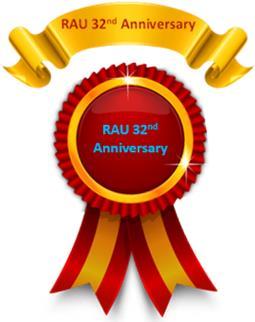


374.
[3] Papadopoulou, P. Exploring M-commerce and Social Media: A Comparative Analysis of Mobile Phones and Tablets. In Research Paradigms and Contemporary Perspectives on Human Technology Interaction; IGI Global, 2017; pp 1–21.
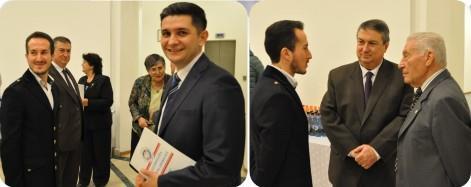
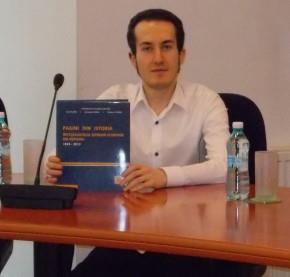
[4] Pelet, J. E.; Taieb, B. From Skeuomorphism to Flat Design: When Font and Layout of M-commerce Websites Affect Behavioral Intentions. In Advances in National Brand and Private Label Marketing; Springer Proceedings in Business and Economics, Springer: Cham, Switzerland, 2017; pp 95–103.
[5] Schwartz, E. Mobile Commerce Takes Off. InfoWorld, 2000, Vol. 22 (25), pp 1–32.
[6] Shaffer, R. A. M-commerce: Online Selling’s Wireless Future. Fortune, 2000, Vol. 142 (2), pp 262.
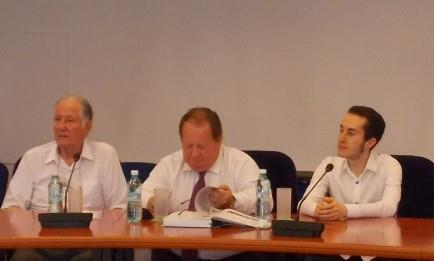

[7] Vanathi, B.; Shanmugam, K.; Uthairaj, V. R. A Secure M-commerce Architecture for Service Provider to Improvise Quantity and Quality of the Product Using Fingerprint Authentication and Gender Classification. Asian J. Inf. Technol. 2016, 15 (2), 232–242.
[8] Young, D. Will Security Power M-commerce? Wireless Review, 2001, Vol. 18 (8), p 12.
–
24
Social Commerce Ecosystem, Social Media Marketers’ New Tool ChatGPT, and ECommerce Profitability Improvement Based on Immersive Product Imagery
Abstract
It's the real time now to better understand the layers of the social commerce ecosystem, and the moving forward march of social commerce. There are obvious significant recent shifts within the social media networks, the pay-toplay model of social media, and social media marketers’ new tool ChatGPT. Marketers need to look carefully at the purchases made on social media, and social commerce driven by the product discovery, paying attention to ecommerce profitability improvement based on immersive product imagery. It is absolutely necessary to exploit change as an opportunity, and improve phygital retail.
Keywords: Social Commerce; Social Media; Generative AI; ChatGPT; E-Commerce; Immersive Product Imagery

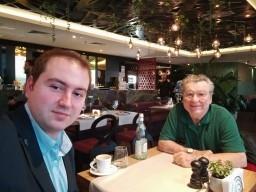
JEL Classification: D83; L21; M21; M31; M37; O31; O33

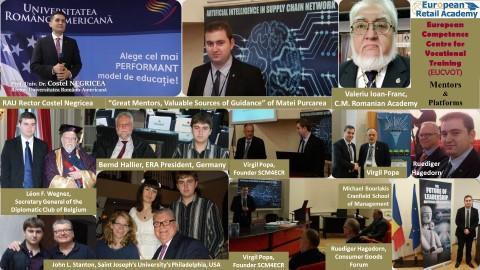


Layers of social commerce ecosystem, and the moving forward march of social commerce

In our last RDC Magazine issue (Purcarea, 2022), we made reference to how important is identifying overlapping of social commerce, social media e-commerce marketing, and social selling (see figure below), thinking holistically (McConnell, 2022), considering including the huge power of social media as advertising channel, one hand, and social commerce as a sum of social media plus e-commerce (Yieldify, 2022), the other hand. The moving forward march of social commerce was underlined, for instance, by Manhattan Associates (2023) from the very beginning of 2023, within this framework being shown consumers’ willingness to buy and checkout on social media, and companies’ increased investigation of both traditional marketplaces, and social media platforms as sales channels in order to improve younger demographics’ reach to, as well as significant expectations regarding: the acceleration of various payment and social shopping platforms’ proliferation; greater progress in automation and robotics; retailers’ work on quickly responding to the ongoing disruption and closing fast the inventory visibility gap; increased social responsibility and sustainability.
In January this year Coresight Research (Winnick, 2023) brought to our attention a recent Innovator Intelligence report, and putted in discussion key opportunities (considering key components of the social commerce market such as: user-generated content/UGC, livestreaming, and advanced technologies) in the relevant social commerce market of the United States, starting from the layers of social commerce ecosystem: the social channels (presented as including not only the social media platforms, but also the news apps, messaging apps, and video/audio platforms), social commerce marketplaces (presented as extending across not only the livestreaming shopping and peer-to-peer marketplaces, but also across social shopping websites/apps and group shopping), technology integration (presented as technologies which are integrated for the enablement of not only the storefront
25
creation, data analytics and creator affiliate programs, but also the user-generated content/UGC enablement) In order to achieve success in this relevant social commerce space of the United States, Coresight Research investigated some brands’ and retailers’ opportunities, as shown in figure below. Within this framework, Coresight Research highlighted, for example, the growth potential of livestreaming e-commerce (taking into account the new level of interaction enabled throughout the course of the channels through which a customer might find and purchase a product) between a brand and shoppers, and analyzed: how brands and retailers are offering customers (by using third-party platforms and establishing their own livestream shopping channels) improved livestream shopping experiences; what are the implications for brands and retailers, so as to better connect with (based on innovative and authentic UGC use) and attract customers (based on valorizing live shopping).
Figure no. 1: Four Key Opportunities in US Social Commerce
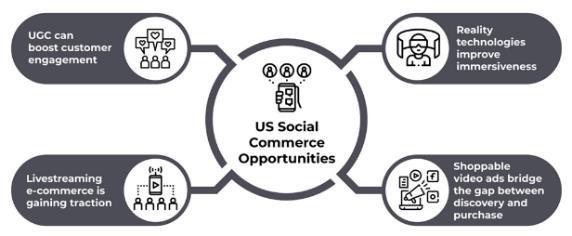
Source: Winnick, S., 2023. Innovator Intelligence: Achieving Social and Live Commerce Success with Authentic, Interactive and Engaging Content, Coresight Research, January 19, 2023 (work cited)
Some month ago, views from McKinsey’s E-commerce Global Initiative, NeXT Commerce (Becdach et al., 2022) underlined: the paradigm shift represented by the dynamic world of social commerce, both products, and complete transactions being investigated by consumers from within an app through social media and content creation platforms like Pinterest and TikTok; this transformation of the customer journey making it imperative to act on social commerce that opens new windows of opportunities by removing friction from the buying process thanks to innovative buying options and social-first content.
On the other hand, it is also worth mentioning the growing interest, from both businesses and buyers, clearly manifested by the mobile social commerce, within the context not only of the mobile app users’ increasing number, but also of the significant mix of e‐commerce and sharing features of the mobile social commerce platforms, as recently highlighted by Liu et al. (2023) Within this framework, allow us to also remember that as demonstrated by Al-Adwan et al. (2019): the (in value) perceived differences in convenience and personalization (having a positive influence) and risk perceptions (having a negative influence) are essential in determining consumers’ intention to switch from traditional (internet-based) e-commerce to m-commerce (mobile commerce); the (in technology) perceived differences in communication networks and end-user devices (having a significant positive influence) are also essential in determining consumers’ intention to make this switch.
Significant recent shifts within the social media networks, the pay-to-play model of social media, and social media marketers’ new tool ChatGPT
As recently confirmed by Statista (Dixon, 2023): in US are the most top ranked social networks (having more than 100 million users originated here), while as a result of the local context and content the Chinese social networks like WeChat, QQ or video sharing app Douyin (the owner of TikTok as this network’s international version) gathered in their regions most people; Facebook is the market leader first surpassing (as social network) one billion registered accounts (sitting currently at more than 2.9 billion monthly active users); Meta Platforms are the biggest social media platforms (Facebook as core platform, WhatsApp, Facebook Messenger, and Instagram, having all over one billion monthly active users each; over 3.7 billion monthly core Family product users being reported by Facebook in Q4 2022).
According to Insider Intelligence (Enberg, 2023), in 2023, from the point of view of the 5 million new US social buyers, for instance, TikTok will be the explanation for the most of them, and this within the context in which: social commerce sales will become more appealing, being capable of growing at high speed (over three times compared to total e-commerce sales); Generations Z and Y are targeted by social commerce strategies depending on creators (with TikTok being a major driver of the new social commerce sales), marketers’ influencer marketing strategies needing to be re-evaluated. The more so, as shown by HubSpot (Alfred, 2023), the new trend of
26
deinfluencing achieved, in the first weeks of this year, over 160 million videos on TikTok (rapidly evolving from “buy less” into “buy this, not that”), despite the fact that deinfluencing could be also interpreted as a building trust strategy in order to determine another purchase happening in every case.
A recently by Rival IQ released 2023 Social Media Benchmark Report (Farley, 2023), that analyzed 150 companies (from 14 industries, including media, retail, food & beverage etc.) having an active presence across major social media networks (Facebook, Instagram, TikTok, Twitter), underlined significant idea to be remembered: the falling (Instagram) or flatlining (Facebook, Twitter) of the organic engagement: falling or flatlining; the declining (Facebook, Twitter) or flatlining (Instagram) of the posting frequency; the increased popularity of hot holiday hashtags (taking part in the happening conversations on the social media platforms on the occasion of the special themed days, each with their own hashtag), compared with the contests and giveaways which were ignored by the public; the most engaging post type is Reels (video posts, under 15 min., intended for people who don’t currently follow you), that is ruling on Instagram; TikTok is having reached the highest position in the charts Also recently, Vox (Ghaffary, 2023) brought to our attention how under pressure is now the free model of social media (known as being subsidized by advertising), and how that can be seen as the start of the pay-to-play era of social media. This situation being determined by various factors (such as: reduced investments on the advertising market, much more difficult for social media apps to sell advertisements because of regulation, increased privacy restrictions generally). Of course, this pay-to-play model is seen as being exposed to major risks within the context of a real turning away from social media of many young people (including by seeking more convenient alternative apps).
According to Tanner (2023), social media marketers real need to create engaging and personalized written content is opening the window of opportunity to make use of ChatGPT (as a new content writer, and social media content strategist – see also the below figure), whose advanced language understanding capabilities (being a machine learning model) allow social media marketers to offer rapidly and easily their customers unique highquality content, better resonating with them Tanner gave a lot of examples (such as: social media captions, blog posts, customer service, product descriptions, Instagram stories, email campaigns, Facebook posts, Twitter threads, YouTube videos, podcasts) of how this new tool ChatGPT can be used by social media marketers by both asking the right questions, and providing the right information.
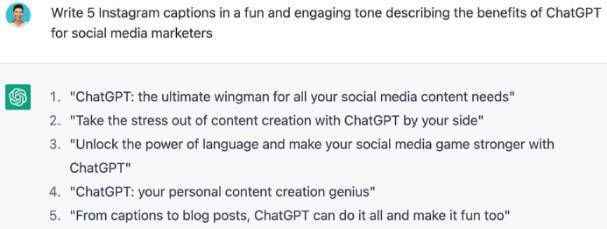
Source: Tanner, D., 2023. ChatGPT: Your New Social Media Marketing Secret Weapon, Social Media College, January 20, 2023 (work cited)
We recently made reference (Purcarea, 2023) to the fine linkage between e-commerce acceleration and advancing marketing technology stake, highlighting valuable conversations about AI (from Dall-E to ChatGPT) and its impact on digital marketing, generative AI & personalization, the exponential change fueled by the impressive technological innovation, companies’ need of establishing a clear digital vision, retailers’ important priorities within the digitally driven commerce etc. At the beginning of February this year Visual Capitalist (Routley, 2023) introduced an Infographic (as shown below) in which the generative AI was explained by AI (the article being generated by ChatGPT based on specific prompts).
Very recently, the global company Stefanini (2023) underlined digital marketers’ need to learn from the many use cases with regard to ChatGPT (generating SWOT analyses for competitors’ better understanding; better planning and executing digital marketing campaigns) and generative AI (digital marketing gaining advantage from it by improving audience reach and engagement) Also recently, Marketing Dive (Kelly, 2023) showed different experts’ opinions regarding the impact of ChatGPT on advertising, new jobs’ creation or (at least) marketers’ new skill setting, without forgetting to also bring the attention on ethical implications related to the use of the AIgenerated content
Figure no. 2: Write 5 Instagram captions in a fun and engaging tone describing the benefits of ChatGPT for social marketers
27
Source: Routley, N., 2023. Infographic: Generative AI Explained by AI, Visual Capitalist, February 1, 2023 (work cited)

Allow us to also add here that:
• Within the context of the significant debate on the European Union (EU) Artificial Intelligence Act (EU AI Act), it was very recently launched a CEPS (Centre for European Policy studies, a leading independent Think Tank on European Policies) Explainer advocating on a broader definition of AI (Renda and Engler, 2023). Priorly, the same authors proposed a very interesting typology of the AI value chain (Engler and Renda, 2022);
• CB Insights (2023) recently analyzed the OpenAI’s (the maker of the generative AI tools ChatGPT and DALL-E 2) investment strategy in the next generation of AI startups (see figure below), the general productivity tools and industry solutions being the top themes (the generative AI being valorized by the most of OpenAI’s portfolio companies in their tools).
Figure no. 3: What is Generative AI?
28
Source: CB Insights, 2023. Analyzing OpenAI’s investment strategy: How the ChatGPT maker is building a generative AI ecosystem, Research, February 24, 2023 (work cited)

Purchases made on social media, and social commerce driven by the product discovery
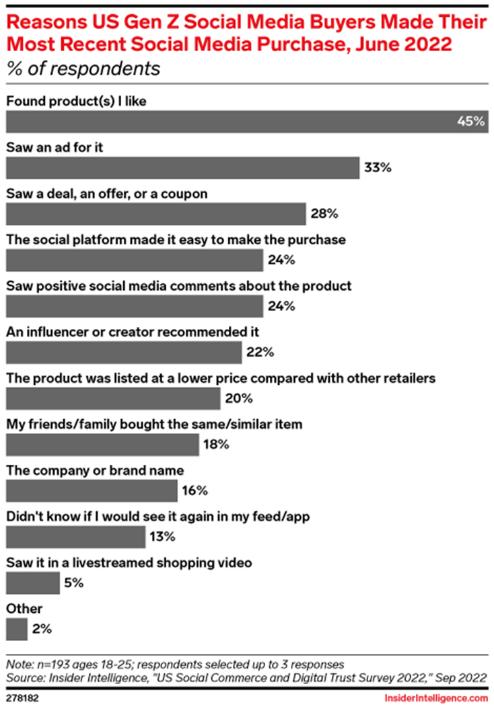
As demonstrated by Insider Intelligence the digitally native (US) Generation Z is the more connected to the social platforms, being well-known, for instance, for its continuous online researching and WOM recommendations seeking (Brown et al., 2022), for digital payment technologies’ embracing (such as mobile wallets, contactless solutions, and peer-to-peer payment apps, being interested in alternative payment methods like BNPL), for their (whether on social media, a website, or an app) expectations regarding a seamless DCX, for their interest in social commerce (see figure below) driven by the product discovery (Feger, 2023).
Source: Feger, A., 2023. How Gen Z shops and buys in 5 charts, Insider Intelligence, Feb 21, 2023 (work cited)
Also, according to Insider Intelligence (Willens, 2023) if this digitally native (US) Generation Z is considered the social video generation (in terms of user penetration TikTok being surpassed by YouTube), its platform is TikTok from the point of view of the time spent weekly with select apps, as shown in figure below.
Figure no. 5: OpenAI Investment Thesis Map
Figure no. 6: Reasons US Gen Z Social Media Buyers Made Their Most Recent Social Media Purchase, June 2022
29
Figure no. 7: Time Spent Weekly With Select Apps by US Gen Z, Sep 2022

Source: Willens, M., 2023. Gen Z is the social video generation, and TikTok is its platform, Insider Intelligence, Feb 13, 2023 (work cited)
E-commerce profitability improvement based on immersive product imagery
A recent valuable Custom Report entitled “CGI and 3D Product Imagery: The Future of Visual Merchandising in E-Commerce” and produced by Coresight Research (2023), in partnership with the visual emerchandising SaaS platform Nfinite, analyzed data from an online survey (conducted by Coresight Research in December last year) of near 200 executives across brands and retailers in the US, UK, France and Germany. Coresight Research focused on brands’ and retailers’ challenges with regard to the production and management of product visuals for e-commerce (so as to improve consumers’ engagement, retention and revenue), one hand and the evolving Computer-generated imagery (CGI – 3D rendering) generally, the other hand. Among the significant research findings and identified key insights (see figure below) it was underlined (as a key insight) that the action of arranging AI in layers has a multiplicative effect on computer-generated imagery for visual merchandising, more than two-thirds of respondents indicating (a research finding) their intention to invest in AI in order to automate product visual content on online channels, both brands and retailers recognizing multiple AI benefits (for example, Nvidia already announced, in November last year, the launch of its Magic3D text-to-3D content creation tool) when coupled with computer-generated imagery.
Source: Coresight Research, 2023. CGI and 3D Product Imagery: The Future of Visual Merchandising in E-Commerce. [pdf] Custom Reports, Deborah Weinswig, CEO and Founder Coresight Research, Deep Dive, February 16, 2023, p. 5 (work cited)
It is also worth mentioning that as shown by the above-mentioned report, respondents recognized different perceived benefits of investing in computer-generated imagery which rapidly creates (through 3D models) new product visuals and support consumers’ confidence in their purchase decisions (52% of respondents recognized
 Figure no. 8: CGI and 3D Product Imagery: Summary of Selected Survey Findings and Key Insights
Figure no. 8: CGI and 3D Product Imagery: Summary of Selected Survey Findings and Key Insights
30
product returns reduction as a perceived benefit; 49% - speed to market improvement; 44% - effectiveness of social media marketing improvement; 43% - company’s ability to A/B test product visuals improvement; 40% - sales conversion increase; 39% - company’s carbon footprint improvement; 38% - effectiveness of company’s e-mail marketing improvement; 36% - e-commerce profitability improvement; 31% - reusability of product visuals increase; 29% - overall costs reduction).
Instead of conclusions: Exploiting change as an opportunity, and improving phygital retail
There is no doubt the imperative of improving today’s social commerce performance, as well as today’s performance of the phygital retail It is not accidental, for instance, that:
• According to Lin & Wang (2022), it is necessary to valorize the social media tools based on consumers as both information seekers, and information providers, and this in order to improve e-commerce effectiveness;
• In the opinion of a content specialist for Sprout Social (Kenan, 2023) it is necessary to make companies’ social commerce strategy evolve, keeping under careful observation the e-commerce trends (such as: mobile shopping accelerated use, evolving social commerce, personalization as a preferred shopping experience, learning more about shoppers with the help of AI, what is on consumers’ minds regarding zero-party data and privacy, online shopping experiences enhanced by AR and VR, voice search rise, businesses focus on optimizing for conversion, retaining loyal customers with the help of subscriptions, how consumers are choosing brands that align with their beliefs, livestream shopping, and conversational marketing)
Let us end by making reference to:
- Some ideas expressed by the Conversational AI leader Heyday (the AI platform Heyday was acquired two years ago by the social media management leader Hootsuite): “In the age of mobile commerce and messaging, marketing, sales and support are starting to merge to create a seamless customer experience… Conversational bots in ecommerce are widely used for customer service as chatbots can resolve a basic issue or query instantly and even retrieve information from existing databases to provide relevant answers. Chatbots deliver faster responses, handle multiple requests simultaneously and are easily scalable… There is a lot of noise around conversational AI chatbots and you should be able to separate the wheat from the chaff meaning, you have the tools to identify the best solution for your ecommerce business. Here’s the checklist you should be looking at while choosing the right solution…” (Heyday, 2023);
- What the Vice President of revenue marketing at conversational marketing platform Drift, Justin Keller, told Retail Brew (Allsup, 2023): “It’s not enough to say, ‘Well, I’ll adopt GPT-3 and the world will look hunky-dory, because everyone else will adopt GPT-3 too.’ That just becomes kind of part of being in business”;
- The interesting experiment made by Ethan Mollick (2023), Professor of Management at the Wharton School of the University of Pennsylvania, who “asked Bing and ChatGPT to create assignments and rubrics for an essay on team performance”, then “gave the assignment to the other chatbot, and return the assignment to the original to assign grades ” Take a look at the results of this experiment: “Bing gave ChatGPT 70%. ChatGPT gave Bing an A;”
- (and last but not the least) The well-known wise words of Peter Drucker: “Follow effective action with quiet reflection. From the quiet reflection will come even more effective action”; “The entrepreneur always searches for change, responds to it, and exploits it as an opportunity”.
References
Al-Adwan, A.S., Alrousan, M., Al-Soud, A. and Al-Yaseen, H., 2019. Revealing the Black Box of Shifting from Electronic Commerce to Mobile Commerce: The Case of Jordan, Journal of Theoretical and Applied Electronic Commerce Research 14, no. 1, pp. 51-67. https://doi.org/10.4067/S0718-18762019000100105.
Alfred, L., 2023. What Does the De-influencing Trend Mean for Influencer Marketing? HubSpot, February 16, 2023. [online] Available: <https://blog.hubspot.com/marketing/deinfluencing?> [Accessed 17 February 2023].
Allsup, M., 2023. Retail’s chatbots are evolving, and bringing new challenges, Retail Brew, February 14, 2023. [online] Available at: <https://www.retailbrew.com/stories/2023/02/14/retail-s-chatbots-are-evolving-and-bringing-new-challenges?> [Accessed 15 February 2023].
Becdach, C., Brodherson, M., Gersovitz, A., Glaser, D., Kubetz, Z., Magni, M. and Nakajima, J., 2022. Social commerce: The future of how consumers interact with brands. [pdf] McKinsey & Company, views from McKinsey’s E-commerce Global Initiative, NeXT Commerce, October 2022, pp. 1-8. Available at: <socialcommerce-the-future-of-how-consumers-interact-with-brands-vfinal> [Accessed 24 October 2022].
31
Brown, T., Digalaki, E., Montez, T. and Van Dyke, D., 2022. Banking Trends to Watch for 2023, Insider Intelligence, Report, Dec 14, 2022. [online] Available at: <https://www.insiderintelligence.com/content/banking-trends-watch-2023?> [7 January 2023].
CB Insights, 2023. Analyzing OpenAI’s investment strategy: How the ChatGPT maker is building a generative AI ecosystem, Research, February 24, 2023. [online] Available at: <https://www.cbinsights.com/research/openai-investment-strategy/?> [Accessed 26 February 2023].
Coresight Research, 2023. CGI and 3D Product Imagery: The Future of Visual Merchandising in E-Commerce. [pdf] Custom Reports, Deborah Weinswig, CEO and Founder Coresight Research, Deep Dive, February 16, 2023, pp. 1-13. Available at: <CGI and 3D Product Imagery- The Future of Visual Merchandising in ECommerce Feb 16 2023> [Accessed 16 February 2023].
Dixon, S., 2023. What is the most popular social media platform worldwide? Statistics, Feb 14, 2023. [online] Available at: <https://www.statista.com/statistics/272014/global-social-networks-ranked-by-number-of-users/> [Accessed 26 February 2023].
Enberg, J., 2023. ‘De-influencing’ is still… influencing, Insider Intelligence, Feb 22, 2023. [online] Available at: <https://www.insiderintelligence.com/content/deinfluencing-still-influencing?> [Accessed 22 February 2023].
Engler, A., Renda, A., 2022. Reconciling the AI Value Chain with the EU’s Artificial Intelligence Act, CEPS, 30 Sep 2022. [online] Available at: <https://www.ceps.eu/ceps-publications/reconciling-the-ai-value-chain-with-the-eus-artificial-intelligence-act/> [Accessed 26 February 2022].
Farley, N., 2023. Organic engagement and traffic from social networks has been shrinking every year, Search Engine Land, February 22, 2023. [online] Available at: <https://searchengineland.com/social-media-engagement-hits-a-new-low-except-for-tiktok-393395?> [Accessed 23 February 2023].
Feger, A., 2023. How Gen Z shops and buys in 5 charts, Insider Intelligence, Feb 21, 2023. [online] Available at: <https://www.insiderintelligence.com/content/howgen-z-shops-buys-5-charts?> [Accessed 22 February 2023].
Ghaffary, S., 2023. Social media used to be free. Not anymore, Vox, Feb 21, 2023. [online] Available at: <https://www.vox.com/recode/2023/2/21/23609375/metaverified-twitter-blue-checkmark-badge-instagram-facebook?> [Accessed 24 February 2023].
Heyday, 2023. How to define your Conversational AI needs. [pdf] Ebook, Hootsuite, Retail planning, pp. 9, 13, 33. Available at: <Heyday by Hootsuite _ Ebook _Retail planning 2023> [Accessed 1 February 2023].
Kelly, C., 2023. ChatGPT might change advertising but it won’t revolutionize it, Marketing Dive, Jan. 31, 2023. [online] Available at <https://www.marketingdive.com/news/chatgpt-AI-marketing-advertising-revolutionize/> [Accessed 24 February 2023].
Kenan, J., 2023. 13 Ecommerce trends you need to know in 2023, Sprout Social, February 13, 2023. [online] Available at: <https://sproutsocial.com/insights/ecommerce-trends/> [Accessed 26 February 2023].
Lin, X. & Wang, X., 2022. Towards a model of social commerce: improving the effectiveness of e-commerce through leveraging social media tools based on consumers’ dual roles, European Journal of Information Systems, DOI: 10.1080/0960085X.2022.2057363.
Liu, Y., Li, Q., Edu, T., Fam, K.-S., Zaharia, R., Negricea, C., 2023. Mobile Social Commerce content, consumer emotions and behavior, International Journal of Consumer Studies, First published: 04 February 2023. https://doi.org/10.1111/ijcs.12908.
Manhattan Associates, 2023. 7 predictions all retail & supply chain experts need to watch out for in 2023, January. [online] Available at: <https://www.manh.com/engb/blog/omnichannel-commerce-digital-supply-chain/7-predictions-all-retail-supply-chain-experts-need?> [Accessed 23 January 2023].
McConnell, B., 2022. 6 Ways to Use Social for Media Ecommerce in 2023, Hootsuite, Social, November 23, 2022. [online] Available at: <https://blog.hootsuite.com/social-media-ecommerce/> [Accessed 7 December 2022].
Mollick, E., 2023. It’s the AI homework showdown! Available at: <https://twitter.com/emollick/status/1628958883539570688?> [Accessed 26 February 2023].
Purcarea, I.M., 2022. E-Commerce Personalization Wanted by the Next Generation of Shoppers. Livestreaming E-Commerce, Q-commerce, Social Commerce, and the Metaverse, Romanian Distribution Committee Magazine, vol. 13(4), pp. 40-55, December.
Purcarea, I.M., 2023. E-Commerce, Marketing Technology Stake, and Improved DCX, Holistic Marketing Management, Volume 13 (1), pp. 30-40, February.
Renda, A., Engler, A., 2023. What’s in a name? Getting the definition of Artificial Intelligence right in the EU’s AI Act. [pdf] CEPS Explainer, 2023-02, pp. 1-5. Available at: <CEPS-Explainer-2023-02_Definition-of-AI-right-in-the-EUs-AI-Act> [Accessed 23 February 2023].
Routley, N., 2023. Infographic: Generative AI Explained by AI, Visual Capitalist, February 1, 2023. [online] Available at: <https://www.visualcapitalist.com/generative-ai-explained-by-ai/> [Accessed 14 February 2023].
Stefanini, 2023. Use Cases For Chat GPT In Digital Marketing, Insights, 22 February 2023. [online] Available at: <https://stefanini.com/en/insights/news/use-casesfor-chat-gpt-in-digital-marketing> [Accessed 24 February 2023].
Tanner, D., 2023. ChatGPT: Your New Social Media Marketing Secret Weapon, Social Media College, January 20, 2023. [online] Available at: <https://www.socialmediacollege.com/blog/open-ai-chat-gpt/> [Accessed 24 February 2023].
Willens, M., 2023. Gen Z is the social video generation, and TikTok is its platform, Insider Intelligence, Feb 13, 2023. [online] Available at: <https://www.insiderintelligence.com/content/gen-z-social-video-generation-tiktok-its-platform?> [Accessed 14 February 2023].
Winnick, S., 2023. Innovator Intelligence: Achieving Social and Live Commerce Success with Authentic, Interactive and Engaging Content, Coresight Research, January 19, 2023. [online] Available at: <https://coresight.com/research/achieving-social-commerce-success-with-authentic-interactive-and-engaging-content/?> [Accessed 20 January 2023].
Yieldify, 2022. Best Social Media Platforms for Ecommerce That You Should be Using, Published: 05/12/2022. [https://www.yieldify.com/blog/best-social-mediaplatforms-for-e-commerce/] Available at: <https://www.yieldify.com/blog/best-social-media-platforms-for-e-commerce/> [Accessed 24 December 2022].
32
Review 1990, Power for Silk Road, andCZ Summit 2023


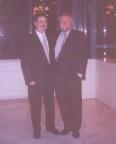


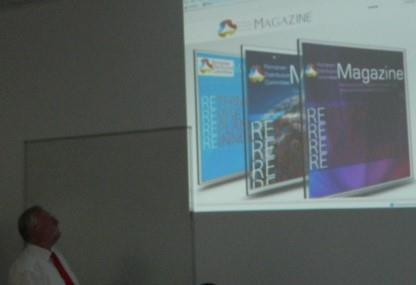
Prof.Dr.BerndHALLIER

Prof. Dr. Bernd Hallier, President of the European Retail Academy

http://www.european-retail-academy.org/), an Committee, and distinguished Member of both Committee Magazine”, and the Editorial Board of RAU “Holistic Marketi brought to our attention other great events happening in the last time, and allowed us to present them. It is also worth remembering that: immediately after visiting Romania for the first time on the occasion of the 24th International Congress of the International Association for the Distributive Trade (AIDA Brussels), Prof. Dr. Bernd Hallier sent us, in May 1998, a memorable letter we have referred initially in the Journal of the Romanian Marketing Association (AROMAR), no. 5/1998, and also later, in 2010, in the first issue of the Romanian Distribution Committee Magazine. The Romanian-American University (RAU) has awarded Prof. Dr. Bernd Hallier a “Diploma of Special Academic Merit”. The “Carol Davila” University of Medicine and Pharmacy, Bucharest, has awarded Prof. Dr. Bernd Hallier a “Diploma of Excellence”

33
Review 1990
In October 1989 in Germany the peaceful revolution of reunification started - but untill autumn 1990 being still within the frame of two independent States. The Trade University (Handelshochschule) Leipzig contacted Prof. Dr. Bernd Hallier and at January 6th 1990 Hallier with colleagues from the trade magazin LebensmittelPraxis visited for the first time officially for two days the VEB Ökonomisches Forschungsinstitut in East Berlin which was the DDRResearch coordination of the East German trade organizations HO, Konsum and Intershop. As one of the results of those talks Hallier invited a delegation from the VEB under its leader Prof. Dr. Klaus Wenzel and a group of Professors from Leipzig to visit the trade exhibition EuroShop.
“It immediately became clear for me that Leipzig as the East German monopoly of exhibitions saw this as a political high-ranking opportunity to make contacts for urgently needed innovations within the trade-sector” Hallier reflected the reception of the East German delegation “I therefore invited also Herbert Schlömann from the Ministry of Economics in Bonn for our first informal talks at the fair ground” (see also pic from dynamic im Handel, 3/90, page 49). “It is surely worth to be mentioned that it was then an initiative of EHI and partners like BBE or HDE and others as well as from the East German VEB to create a German/German Beirat (a kind of consulting team) which was backed by the West German Ministry of Economics and the East German Trade Ministry - but which in principle was driven by human beings in a cluster from the two sides without having any budget for actions as the speed of transformation was much quicker than the regular meetings for example of our EHI Board Meetings” Hallier remembers. “In February 1990 nobody of us thought that it would take only about another half year that we would be united within one German State. But it is a wonderful example for a very creative mix/result with the parameters Uncertainty in Macro-Economics, Entrepreneurial Spirit of Individuals and Fair Grounds as a potential Back Stage for meetings between Players from different Sides with a really great impact on the history of a Country and even beyond its borders. There was no business plan - and in a review more than 30 years later it has to be admitted that a lot of ideas could not be realized: but we used the Challenge to contribute our part within a Civil Society” Hallier concluded.

34
Power for Silk Road
For nearly 15 years Prof. Dr. Bernd Hallier visits the EURASIAN countries and lectures about Retail and Exhibitions. He has promoted among others the Astana Economic Forum, Expo 2017 and the Silk Road Mayors’ Club (see: www.dailymotion.com.video/x6nihg5 ).
Now a group of retailers from EURASIA visited the EuroShop Exhibition: number 1 worldwide for retail technology: in 2023 with exhibitors from 55 countries on 100.000 square meters exhibition area.
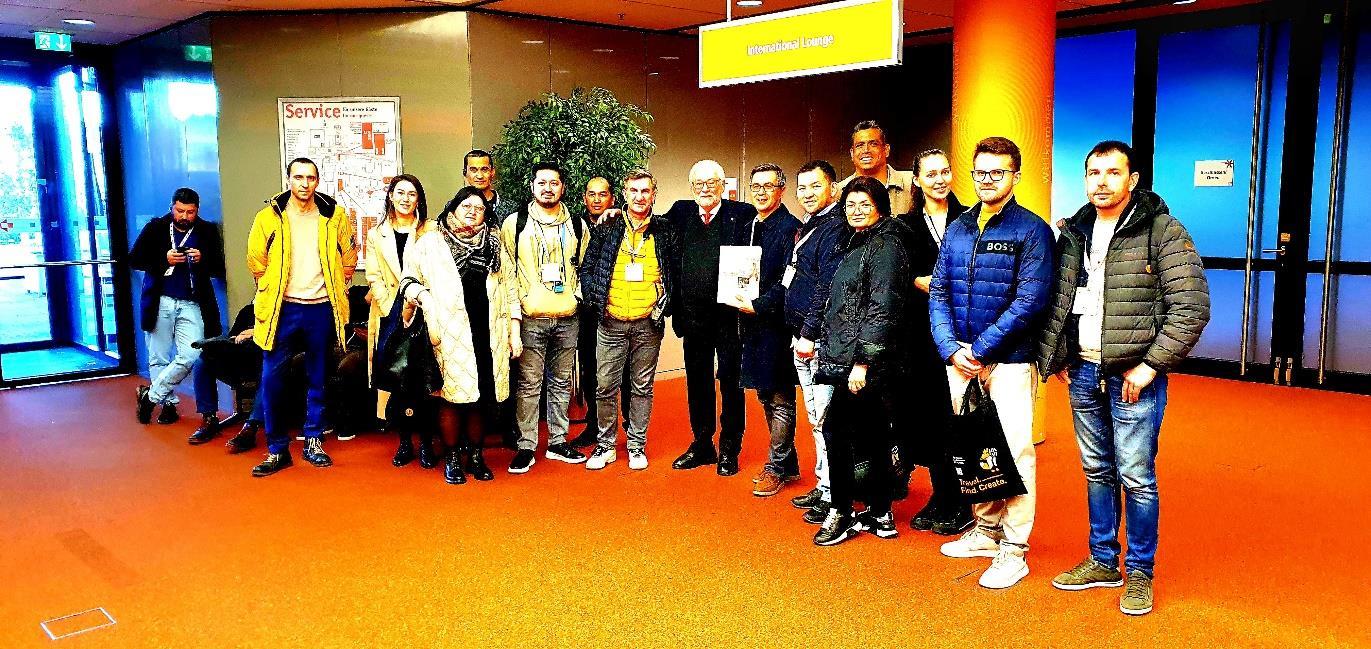
Welcoming the group in Düsseldorf Prof. Dr. Bernd Hallier stated that it is now the time to establish a University Network in Kazakhstan, Kirgizia, Uzbekistan and the neighboring countries to introduce Case Studies of Applied Sciences in the schedules of teaching.
“We could also empower the countries by Erasmus stipends for an exchange of students and trainees” Hallier told the group and advised them to follow also EUCVOT or to connect with AIESEC like he did himself more than 50 years ago in his own student life.
35
CZ Summit 2023
“In November 1989 a Czech/Slovak delegation under the leadership of Prof. Dr. Jiri Jindra visited the EHI in Cologne and we agreed to invite a team to visit EuroShop 1990 and to start a RoundTable Workshop at the VSE University in Prague to discuss how a social market economy works” Prof. Dr. Bernd Hallier remembers the first steps of cooperation. “As a parallel to our EHI Annual Conference/Tag des Handels our colleagues in Prague organized the Conference Goldener Dukat” he added.
“As a next step Prof. Jindra - backed by a team of Tomas Krasny/Dr. Barbora Krasna and Dr. Tomas Drtina (all three at that time as partners of Incoma) - kicked off the CZ Retail Summit as a platform for Applied Sciences of Retail/Wholesale based on three pillars: the VSE University + its Academic partners, the newly founded Confederation of Commerce and Tourism, experts from the national Government/Administration. Further on sponsors had been involved from the start on - which were exhibiting at the lobby of the Conference Hotels” Hallier describes the retail event which today is the greatest show of its kind in Central Europe. In 2023 in March 28-30th more than 1.000 participants, 85 speakers and 60 commercial partners are expected to attend according to the preliminary program (see ). It is worth mentioning in that context that in 2006 Prof. Jindra became the first personality being honored by the ERA-Hall of Fame while Prof. Hallier got awarded in 2011 by a Doctor honoris causa degree of the VSE Prague in an outstanding academic ceremony (see YouTube VSE Prague).
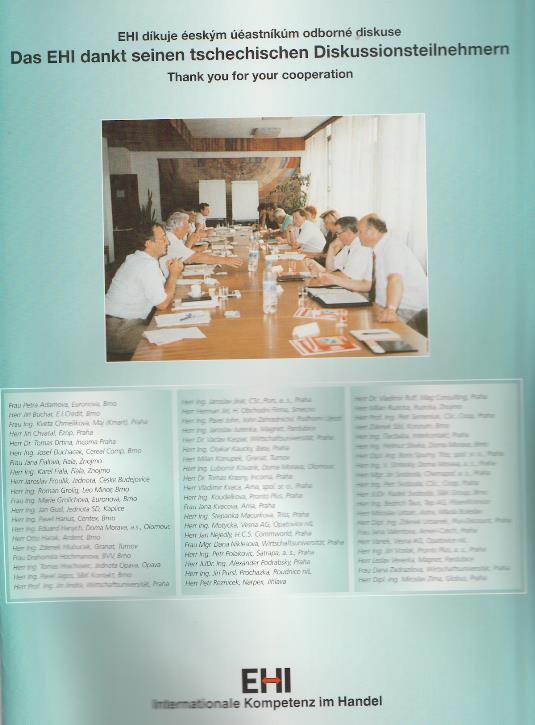
36
THE DARK SIDE OF ENERGY CRISIS SUBSIDIES
09.01.2023

Abstract
Europe is whirling in a lasting energy crisis. For the moment, some positive developments, as well as the adoption of measures aimed at limiting the negative effects of the energy crisis, give the false impression that this is an adventure which, although unpleasant, will nevertheless be limited time. Unfortunately, not only is the energy crisis not ending, but on the contrary, it is causing a series of serious upheavals for Europe. We focus in this article on the effects that are expected to result from spending the sums of money that have already been allocated within the EU in the form of subsidies to deal with fierce energy prices. In particular, for Greece, a member of the EU and the euro zone, the choice of theEUshould cost it,accordingtothe estimates oftheBruegel research center, 3 to 6 points of increase in its debt. Determining criteria is always a challenge, including in the case of energy subsidies in the EU.
Keywords: Energy crisis, Inflation, Subsidies

JEL Classification: B22, B27, D63, E31, H12, L71
Europe is whirling in a lasting energy crisis created by itself, due to some inability to foresee the disastrous consequences of its policies. Its dependence on Russian gas, which represents 50% of its total needs, should have made it extremely cautious in its decisions. It therefore seems inconceivable that Russia's response to the harsh sanctions it chose to impose was not planned
NEGREPONTI-DELIVANIS
Prof. PhD Maria
37
TheacuteenergyproblemfacingEuropeissofarovershadowedbyhugegasreservesandgenerous public subsidies. In addition, the insufficient information of European citizens, carefully maintained by EU leaders, limits their reactions to the unpleasant measures imposed on them. But unfortunately, this lull is likely to be short-lived, as we expect multifaceted disasters that could trigger uprisings.
For the moment, some positive developments, as well as the adoption of measures aimed at limiting the negative effects of the energy crisis, give the false impression that this is an adventure which, although unpleasant, will nevertheless be limited time. I am referring, first of all, to the Russian gas weaning efforts, which began and continue at a rapid pace and in many directions. However, apart from the fact that these efforts need time to bear fruit, the most important risk is the existence of serious doubts as to their degree of success. The prevailing optimism at the moment is due to the price of gas, which today is lower than it was in the summer, although it is still around six times higher than before the war in Ukraine, and even if it fluctuates. It is also due to the introduction by the European Union (EU) of generous public subsidies, which give relief to energy consumers, but which is a short-term measure. In particular, and because the new year will see a return to a tight monetary policy, but also a continuation of inflation, which does not favor subsidies. Moreover, the relative optimism which is cultivated in theEUwith regardtothe energycrisisisalsojustifiedbythefactthat,so far, themeasuresimposed to limit energy consumption have been accepted with relative equanimity by European citizens. Another positive aspect is the finding of the research institute IFO that 75% of German industry (which logically extends to some extent to other EU countries) did not suffer any unpleasant consequences of the energy crisis. And, of course, some hope also rests on the EU setting a gas price cap.
However, this optimism did not take into account a number of processes of the energy crisis, which, although not yet sufficiently felt, still pose serious long-term risks that threaten key socioeconomic sectors in Europe. These threats coincide with the sad revelations, on the one hand, of the lack of solidarity and cohesion within the EU, and on the other hand and above all, of the existence of abysmal corruption, which fuels numerous scandals within the EU. European citizens are today dumbfounded and wonder what they can still expect from Europe. Unfortunately, not only is the energy crisis not ending, but on the contrary it is causing a series of serious upheavals for Europe. These threaten to weaken it and accelerate its international marginalization. This is an unpleasant development, which will first affect the weakest European economies, with the most problems and the highest debts, such as the countries of southern Europe, and above all Greece.
Of all these effects, I focus in this article on those that are expected to result from spending the huge sums of money that have already been allocated within the EU in the form of subsidies to deal with fierce energy prices. Although this amount has not been widely publicized, for obvious reasons of course, the think tank Bruegel reveals that from September 2021 to date, the EU has spent public money to the tune of 700 billion euros, and the spending continues.
Considering the ease with which the European Union approved the expenditure of this program, it is not surprising that it did not take into account the exorbitant amount (to amuse its own more or less inaccurate policy), which moreover does not solve the fundamental energy problems, but only temporarily manages the intensity of their consequences, namely the revolt of European citizens,
38
certain associations are inevitable. Among them, the tragic fate of Greece under the memorandums of understanding, the result of cooperation between the EU and the IMF, comes to the fore.
I am referring to the Greek debt, perfectly sustainable before the memoranda, which was only equal to around 1/3 of the public money already spent on energy subsidies within the EU. Let me add the budget deficit of our country before the memoranda, which could certainly have been addressed by a series of measures that would have limited it. But in the end, for Greece, a member of the EU and the euro zone, we found no solution less inhuman than to choose Iphigenia. Now, once again, with the disaster it has worked in Greece behind it, the EU is unhesitatingly sacrificing climate change, green growth, part of industry and its growth rate, but also the possibility of improving the living conditions of the weakest social classes, but also the pursuit of better public health and better education, a more equitable distribution of income, etc., etc., with the sole aim of slow down the reactions of European citizens to the harmful consequences of the energy crisis, which it has caused by some unfortunate decisions.
In particular, for our poor country, this choice of the EU should cost it, according to the estimates of the Bruegel research center, 3 to 6 points of increase in its debt (a prediction that refers to all economies with high debt). This increase will make it more difficult, if not impossible, to regain the investment grade that our government is now trying to obtain by any means and at any price, will make it more difficult and burdensome to borrow, and will force us to new inhumane austerity and the impossibility of raising wages, which are the lowest in the EU, with the exception of Bulgaria. The counter-argument is well known, and it is the one that currently rejects Kissinger's twice-voiced advice on the need for a diplomatic solution to the war in Ukraine. However, in the case of energy subsidies in the EU, the question of how the criteria on the basis of which they were accepted were chosen, and whether these criteria fit into the wider requirements of democracy, arises reasonably.
Given that this is non-productive spending, which has clearly failed to respond to needs of a much greater magnitude, such as, among others, the adoption of the necessary economic and budgetary policy measures, including the mismatch creates disastrous impasses in Europe, and the forced abolition of the application of the basic economic principle. And the question that arises is: shouldn't the 'democratic' EU have been informed and respected the preferences of European citizens in this respect before proceeding with the allocation of this huge number of subsidies, which has already exceeded 700 billion euros?
Morkenthaou1, 54622, Thessaloniki, Greece +30 2310229977
+30 6944397345
39
● Valeriu IOAN-FRANC – In Memory of Distinguished Professor Léon F. WEGNEZ
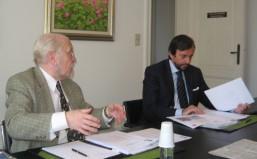
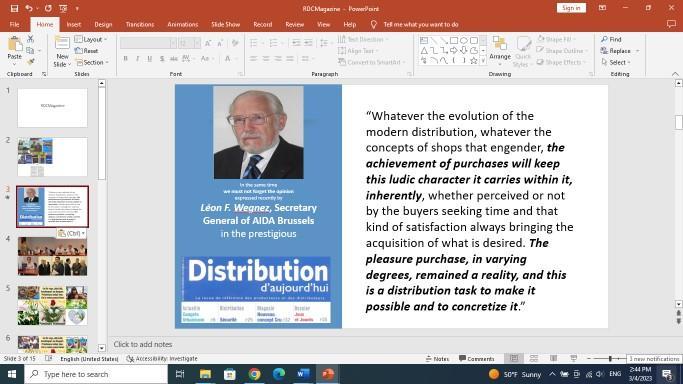

Note from the Editor-in-Chief

Involved with the preparation of the 24th International Congress of A.I.D.A. (organized in Bucharest, at Athénée Palace Hilton, on 18-19 May 1998, and having both a challenging central theme – “Retailers and Suppliers with shared ambitions to improve profit performance by continuously improving the quality of their service to consumers” – and reputed International Keynote Speakers), Valeriu Ioan-Franc had the honor and the pleasure to receive the visit of Distinguished Professor Léon F. WEGNEZ (during the initial working visit) at the “Pierre Werner” Center of Studies and Documentation RomaniaLuxembourg, Romanian Academy House, Bucharest. Discussions were lively, allowing the clarification of questions and concerns. Léon F. WEGNEZ was a well-known personality with a vision and commitment, knowing what to do with the time and having the power to give his life a meaning, with a real vocation for spreading knowledge about the distributive trade, pledging for the right decisions, the right choices and the progress of business life, through a better understanding of consumer value and consumer journey leading to successful marketing. He offered us an innovate and to offer the consumer the best possible experience.
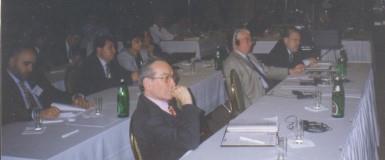



40
In Memory of Distinguished Professor Léon F. WEGNEZ
Léon F. WEGNEZ (https://www.crd-aida.ro/2023/01/grande-tristesse-pour-ungrand-ami-prof-dr-h-c-leon-f-wegnez/) was a great specialist in the theory and practice of commodity science, a visionary, a militant for the development and modernization of trade, but within the limits allowed by the well-being shared by all market players.
He knew how to be above all a consumer and to come up with practice and theory to meet the real wants and needs of consumers. As a true marketing man, who loved the art of selling and gave the merchant-consumer partnership an enormous space in his own existence.
He was also a great friend of Romanians and Romania. Let’s not forget that he encouraged and supported the collaboration with us when we were young, gave us hope and space for expression, made us believe that we also have value and justice in what each of us and the Romanian Distribution Committee do in its entirety.

We remain poorer, lonelier, but strong and able to continue his work with responsibility.
Valeriu Ioan-Franc
Member of the Romanian Academy,
Member of the Spanish Royal Academy of Economic and Financial Sciences – Institute of Spain,
General Deputy Director, National Institute for Economic Research “Costin C. Kiriţescu”, Romanian Academy,
First Vice-President of the Romanian Distribution Committee
41


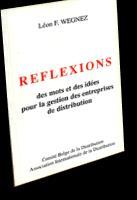





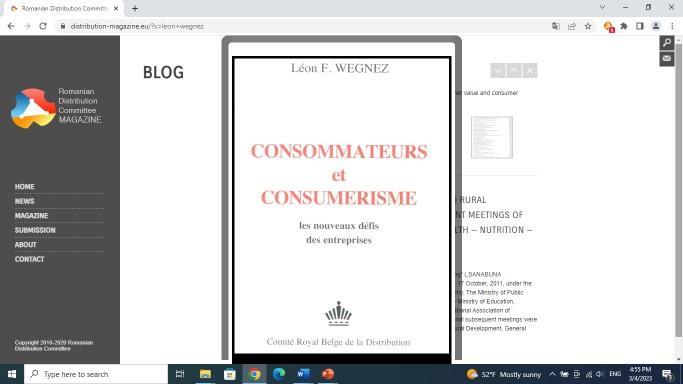


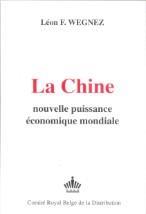
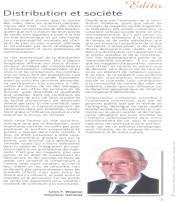
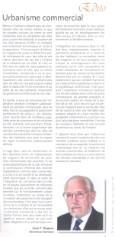

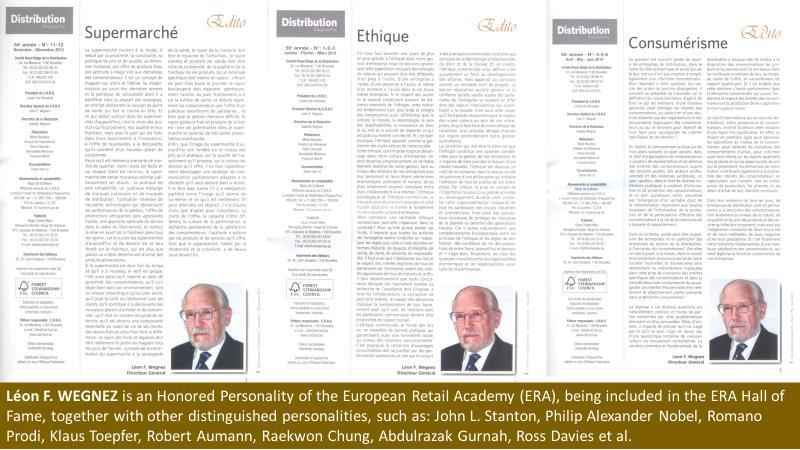
RDC, 08 Jan 2023
●
42
Grande tristesse pour un Grand Ami, Prof. Dr. h. c. Léon F. Wegnez
Grande tristesse pour un Grand Ami, Prof. Dr. h. c. Léon F. Wegnez
C’est avec une grande tristesse que nous venons d’apprendre qu’un Grand Ami, Léon F. Wegnez, Administrateur Secrétaire Général du Club Diplomatique de Belgique (Château Sainte-Anne, Bruxelles), CoFondateur de La Gazette Diplomatique (Bruxelles), Membre de l’Académie Française des Sciences Commerciales, Administrateur Secrétaire Général de l’Association internationale de la distribution, intronisé au Hall of Fame of the European Retail Academy (Allemagne), Conseiller sage et expérimenté des magazines spécialisés de renommée mondiale “Distribution d’Aujourd’hui” et “Distributie vandaag”, l’Auteur d’une vingtaine de livres, Titulaire de nombreuses décorations, vient de s’éteindre à 5h ce matin
En cette circonstance si triste, permettez-nous d’honorer la mémoire du Prof. Dr. h. c. Léon F. Wegnez, les qualités reconnues (le professionnalisme, l’organisation, la pédagogie, l’intelligence, l’empathie, l’élégance, le dévouement à son devoir, la générosité et la solidarité) d’un Grand Ami.
La contribution du Prof. Dr. h. c. Léon F. Wegnez au bon fonctionnement du “Romanian Distribution Committee Magazine” et du “Holistic Marketing Management Journal” du Romanian-American University, en qualité de Membre distingué du Comité de rédaction est bien connue et appréciée. C’est bien connu que Professeur Léon F. WEGNEZ a exprimé constamment sa satisfaction concernant le rôle croissant joué par la Roumanie dans la construction européenne, en considérant toujours que l’élite de la Roumanie est un modèle dans bien des domains et en se félicitant des relations amicales qu’il a pu développer au cours des années avec de grands dirigeants, des recteurs et des professeurs éminents.
Le Professeur Léon F. WEGNEZ, Docteur Honoris Causa de l’École Nationale d’Études Politiques et Administratives (SNSPA) de Bucarest, Roumanie, a bénéficié d'une formation universitaire multidisciplinaire qui l’a conduit notamment à enseigner des matières aussi différentes que la gestion d'entreprise, les langues germaniques, l’informatique et la robotique, l’industrialisation des pays en voie de développement, le droit civil et le droit commercial. Il a notamment contribué à la formation post-universitaire de nombreux diplômés des pays en voie de développement.
Parmi les nombreux ouvrages publiés par Professeur Léon F. WEGNEZ (au plan scientifique, dans les domaines de l’informatique - le premier à écrire un livre sur l’informatique en langue française en Belgique, de la robotique et de l'intelligence artificielle; au plan économique, dans les domaines de la construction européenne, de la vision

43
japonaise de la gestion d’entreprise, du consumérisme et des problèmes de sécurité; au plan diplomatique, dans les domaines de la formation à la diplomatie, des règles qui régissent les relations diplomatiques 2 et de l'avènement de la diplomatie moderne), permettez-nous de rappeler “La nouvelle Europe” et “Le miracle japonais”, qui ont été classes par les critiques parmis les meilleures livres consacrés respectivement à l’Europe et au Japon. Il a été coauteur du “Dictionnaire commercial”, édité par l’Académie Française des Sciences Commerciales et du “Dictionnaire analytique de la distribution”, édité par l’Université de Montréal, Canada, et a publié plus de 2.000 articles traitant les disciplines mentionnées, dans des revues belges et étrangères.

Professeur Léon F. WEGNEZ a organisé en coopération avec le Comité Roumain de la Distribution le 24ème Congrès International de l’Association internationale de la distribution en Mai 1998. C’est bien connue la coopération du 18 Mai 1998 avec les Comissions du Parlement Roumain pour l’Intégration Européenne et pour la Politique Economique, qui a été appréciée comme une expérience mémorable concernant la promotion de la marque nationale.
Il est aussi bien connue la carrière du Professeur Léon F. WEGNEZ dans des organismes belges et internationaux d’étude et de formation, pour lesquels il a notamment organisé de nombreux congrès internationaux et conduit de nombreuses missions d’étude sur les cinq continents. Il a participé, par exemple, à la direction d'une maison d'édition et de librairies, et a occupé plusieurs mandats d’expert dans le domaine de la distribution, du marketing, de la franchise et de la sécurité d'entreprise, en étant amené à travailler étroitement avec de nombreuses instances publiques et privées.

Professeur Léon F. WEGNEZ a reçu des importants distinctions honorifiques belges conférées par S.M. le Roi des Belges, sur proposition du Ministre des Affaires économiques: Officier de l’Ordre de Léopold (2012), Officier de l’Ordre de la Couronne (2002), Chevalier de 3 l’Ordre de Léopold (1991), Chevalier de l’Ordre de la Couronne (1980). Il a aussi reçu une distinction honorifique étrangère: Chevalier de l’Ordre des Saints Maurice et Lazare conférée par la Maison Royale de Savoie.
Pensons aussi au fait que Professeur Léon F. WEGNEZ a commencé de rêver et d’avoir des idées, d’enfoncer les racines des idées et de loger l’inspiration dans la ville de Verviers, l’ancienne cité lainière reconnue mondialement pour ses innovations technologiques dans l’industrie de la laine et, de nos jours, capitale wallonne de l’eau, une ville qui a eu toujours une vie culturelle intense… Ce ne sont que quelques idées des revues mentionnées ci-dessus.
Profondément marquées par la perte inestimable, nous nous associons à la grande tristesse de la Famille Wegnez nos plus sincères condoléances.
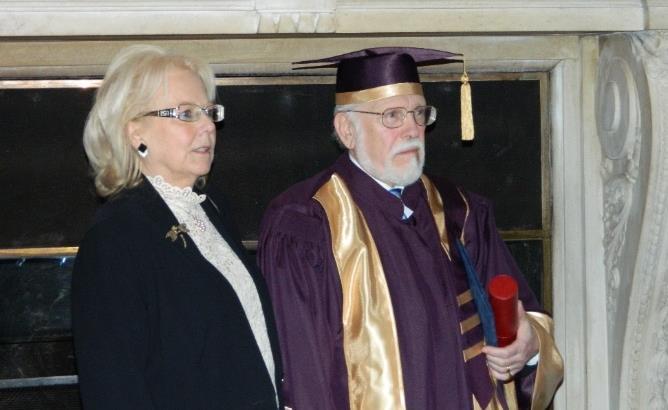
44


























 by Cosmin TĂNASE
by Cosmin TĂNASE




















 Figure no. 8: CGI and 3D Product Imagery: Summary of Selected Survey Findings and Key Insights
Figure no. 8: CGI and 3D Product Imagery: Summary of Selected Survey Findings and Key Insights










































